Once in a while this question is brought up on “Killing Floor 2” related internet boards. “Steam” reports that we have many KF2 players online, typically thousands or even 10K+ playing it concurrently. But do we really have as many players in KF2 as Steam reports we do? Valve Corporation’s “Steam” is a digital video game distribution platform that is used by the Tripwire Interactive LLC (the game studio behind the KF2 game) as their main distribution channel for the game. Although the game can also be purchased and played on consoles (Sony PlayStation and Microsoft Xbox), as well as on the alternative game distribution platform by Epic Games, the number of players on these platforms is very low and the vast majority of KF2 players play it on Steam. And, conveniently, Steam provides a uniform way to count the players who play KF2 on this platform, the “in-game” player count.
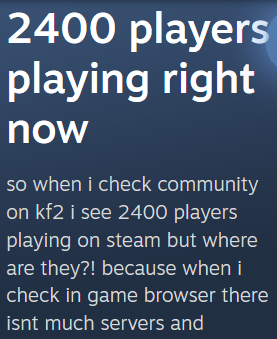
It has been common knowledge among the hardcore players in the last years that the game is actually more dead than it looks like from the Steam “in-game” concurrent player numbers. But why is there a discrepancy? Why the reported players number on Steam seems higher than the actual number of players? What is the actual number of real players in this game? Read on to find out.
A quick rundown of the fake players long read
- The official Steam “In-Game” concurrent player numbers for Killing Floor 2 are inflated, overblown multiple times over;
- For each 1 real KF2 player there are 7 to 9 fake players that are likely farming/trading bots, not human players;
- Outside of seasonal events/discount events there are only 700-1,300 concurrent “in-game” players play this game;
- It’s highly unlikely that this situation is natural in any way;
- Farming bots inflating the numbers artificially is the most likely reason behind the fake players, however, other explanations are also offered;
- The situation worsens with years, starting at ~2K bots and reaching ~11K concurrent bots by now;
- The usual alternative explanations debunked;
- Tripwire Interactive’s stance on the situation (hint: it’s bad).
What is the “In-Game” concurrent player number?
For almost every game on the official Steam video game distribution platform an “In-Game” concurrent player number is maintained. One can easily assess how popular a game is by the amount of players that currently play it. This number is publicly available on every game’s Steam content hub web page:
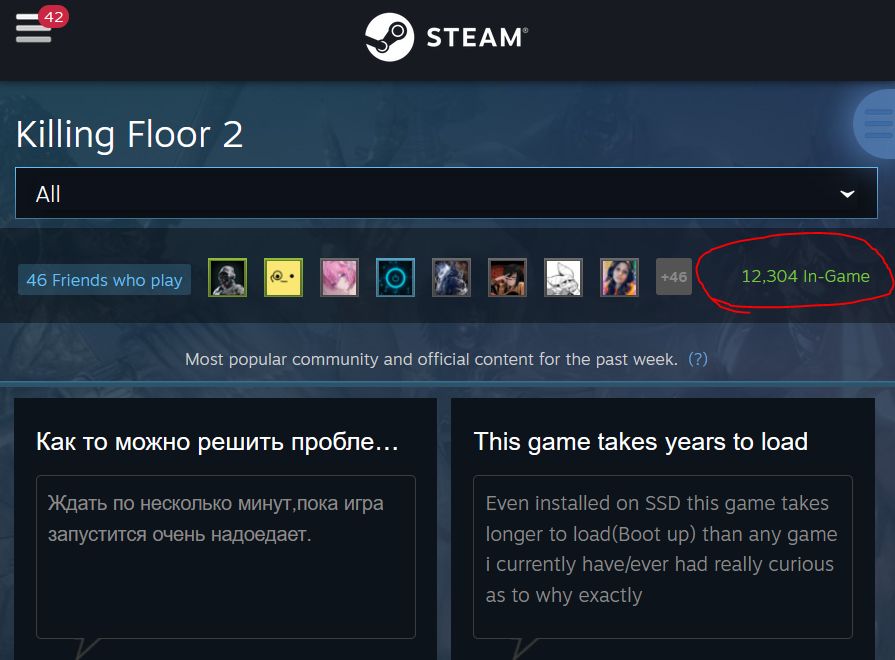
Steam has never published an official explanation of the methodology of how they come up with these numbers, but it’s both common knowledge and widely believed that they just periodically count the concurrent momentary number of steam clients that detect this certain game as running on someone’s PC. It’s always a momentary snapshot of the concurrent player count, taken once in a few minutes, it’s not an average or cumulative number, it’s simply how many players have the game launched at the moment. It doesn’t matter if such players actually joined any online games or are playing solo so-called “offline” games. It doesn’t try to detect if someone actually even plays the game as opposed to having the game just hanging in the background in main menu doing nothing. It doesn’t even validate if it’s the actual game running instead of something else, i.e. a “dummy” pretending to be a game.
How they do it?
There’s a number of bot programs available to the public that allow to report to the Steam cloud services that the game is running while it is not. These programs aren’t games, they are emulators used to convince Steam that a game is running. One of them is “Idle Master” that relies on fooling the working local Steam client into thinking that a particular game or games are running, while actually they are not. Another, which most likely is used by these actors, is “Archi’s Steam Farm“. This is a very lightweight client program that doesn’t rely on any Steam software and employs their own Steam client implementation they achieve through reverse engineering the Steam API and reimplementing only the needed functionality. Which is very useful for running huge bot farms as the lightweightness of the client comes in handy as they don’t have to implement the official Steam client functionality in full. There are very detailed instructions on how to get such bot farms running on any platform: Windows, Linux, MacOS, but from the botmaster perspective, obviously, the best is to rely on the command-line lightweight Linux client, so one can run hundreds or even thousands of bots.
Why they do it?
Besides farming for the idle time in games, the bots achieve the purpose of farming for trading cards and most likely in-game item drops. These items have non-zero value on the steam market:
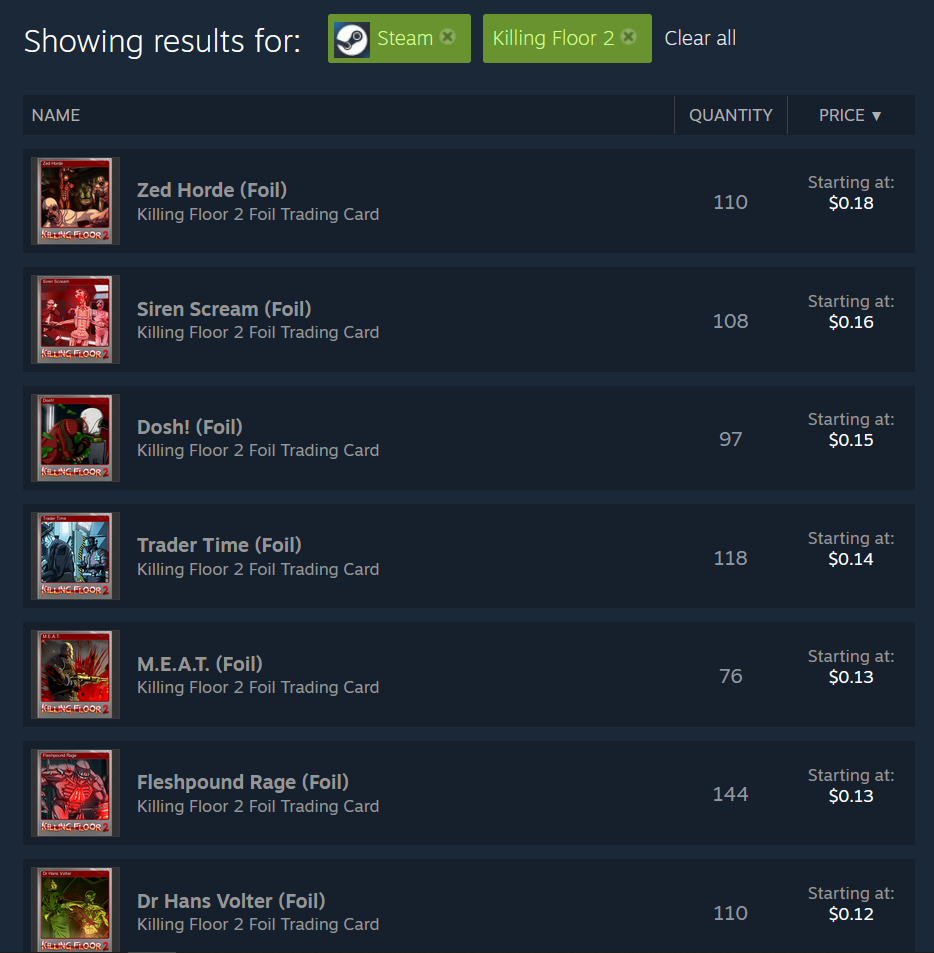
Even more so the in-game drop items:
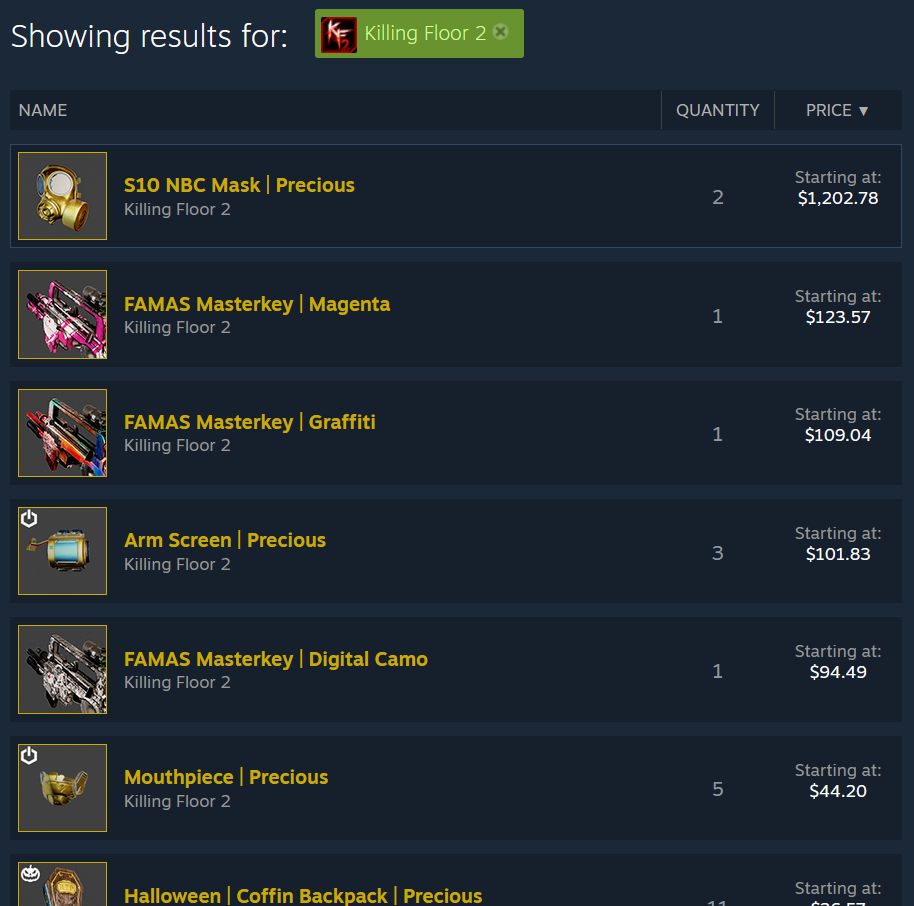
Note that these are sale prices for which there could be no buyers whatsoever, one can list almost any price for their item. If one tracks down the actual purchases though most of these go for a small fraction of the listed price. For example, most of this “Mouthpiece | Precious” purchases, which is for sale on the screencap above for $44.20, were made for below $1 with only a few above $10.
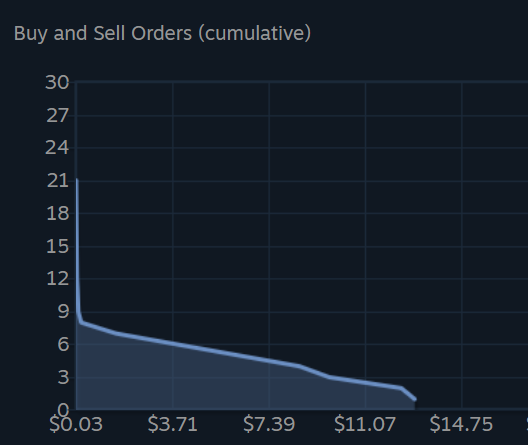
Given the costs of running entry level virtual machines in major cloud service providers (AWS, Azure, GCP, Oracle) being pretty much zero, due to their marketing try & buy campaigns, it’s still not nothing if one can generate some little side income by running huge bot farms. Once configured, these bots both mine and sell the trading cards and the in-game items for you without having to care about them much and generate non-zero income. This is especially true for the operators from 3rd world countries, such as Nigeria, where the value of $1 is much higher than in the US of A and there’s enough technical talent with access to the Internet to set up said bot farms. Overall, from the economics perspective, it’s the most beneficial to run this hustle from countries with the lowest cost of living.
Others may be in a business of managing high quantities of VMs anyway and putting there a lightweight client capable of generating side income doesn’t hurt much.
Each individual installation of ASF is capable of running hundreds of bot instances. Each instance has to have a Steam account associated with it, which are either free (in which case you can accept games as gifts or claim them during F2P times or short $0 sales) to set up or cost a few dollars with plenty of games already in the library to extract trading cards/item drops value out of them.
Although this explanation for the driving forces behind this phenomenon is, what I think, most likely, there could be others, I’ll briefly touch on later in this article.
Proof they do it
Here’s one of the profiles of accounts whose owner likely engages in this type of activity:
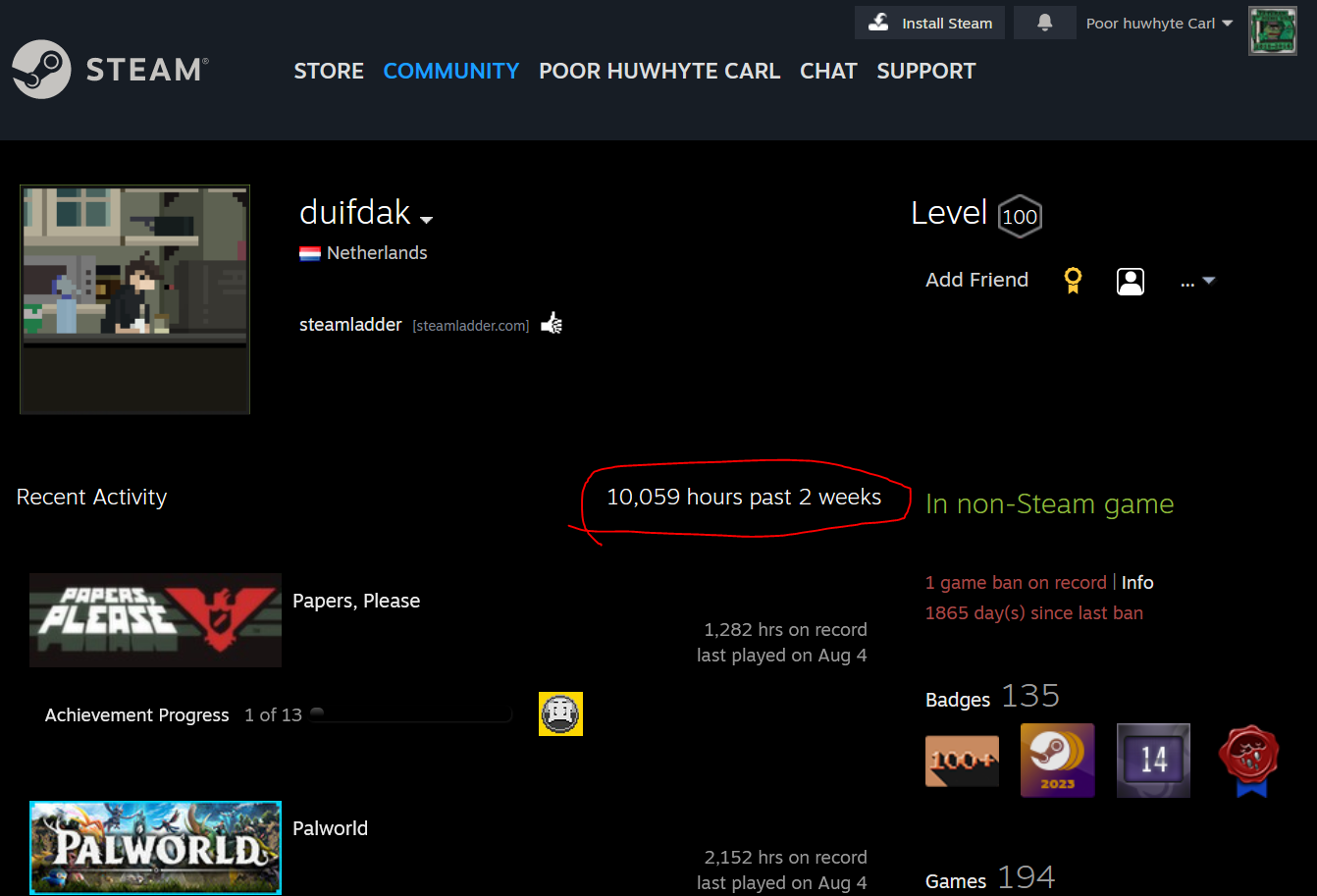
The question is: how did this person manage to get 10K hours played in just 2 weeks, all while the maximum amount of hours one can spend playing in two weeks non-stop is just 336 hours? The obvious answer is this is impossible. What happens here is this account engages in, at the very least, idle time mining and likely other types of mining.
Here’s an example of their achievements in one of the familiar games:
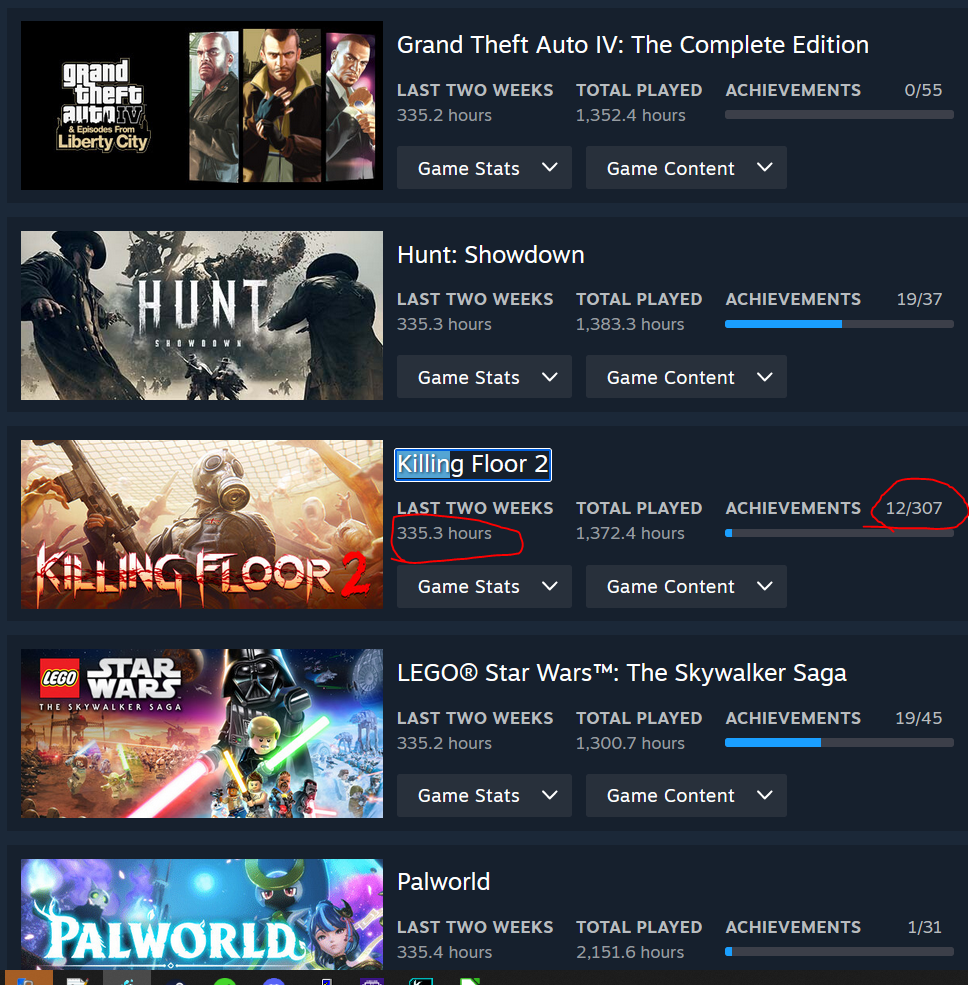
Is it possible that they play Killing Floor 2 for 335.3 hours in 2 weeks, and use the remaining 0.7 hours for necessary biological phases such as sleep, feeding and so on? Of course not. It’s the bot on their behalf does it. Is it plausible that, while spent 1,372.4 hours of playing Killing Floor 2, they managed to get only 12 achievements out of 307? Keep in mind, most of the achievements are really simple, e.g. “kill your first enemy” and so on. No, it’s not plausible at all. Even more so, consider the time span during which they scored these achievements:
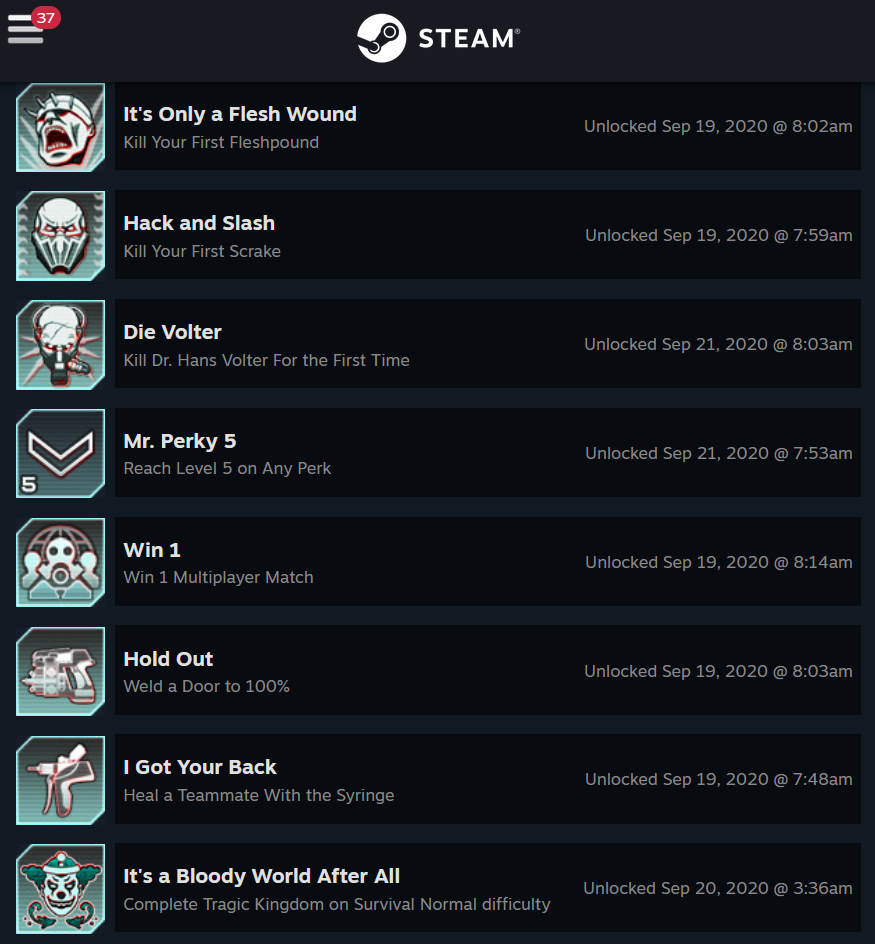
All of their achievement dates span just 3 days around September 20th, 2020. These are the only 3 days during which they’ve actually played the game. The rest is time spent by the bots mining in-game time, but also likely trading cards and in-game drop items. Naturally, this account has a trading activity that, I would say, is more intense than average, to put it mildly:
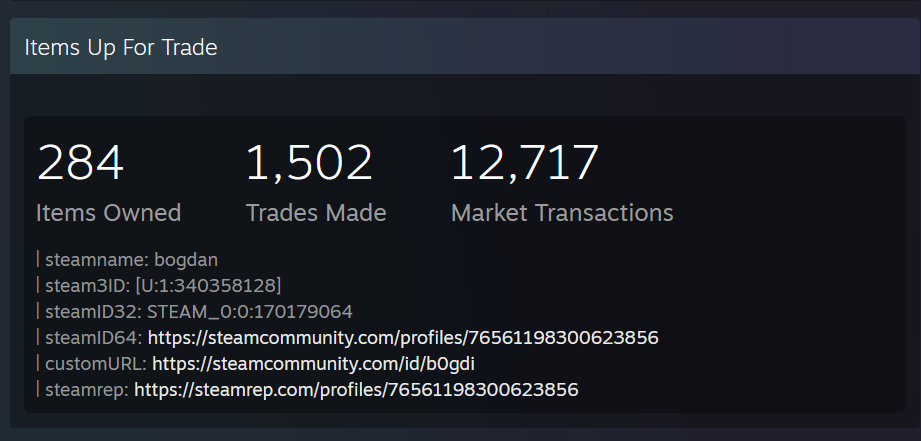
The account name also seems to align well with the theory of roughly 3rd world country residence combined with a relatively good IT knowledge, as “Bogdan” name is common in East European Slavic countries all of which are significantly backwards economically as compared to Western Europe and the US of A, due to the decades of socialism that was about to turn into a full blown communism, which a good share of the US media and academia for whatever reason considers to be the best way to organize society. While they are poor, they are also rather smart and STEM capable, because of the Soviet military industrial complex needed the brains to calculate their nukes trajectories properly, so they naturally had to invest into math and physics heavily and almost all Eastern European countries inherited a strongly STEM-inclined educational system. Combine these two factors and you get a nice soup of all sorts of hustles and swindles to extract money from the internet.
Questioning the official player numbers
There are free services on the Internet that collect and aggregate this info via Steam API calls, one of them is “Steam Charts“, here’s how the KF2 related page there looks like as of now:
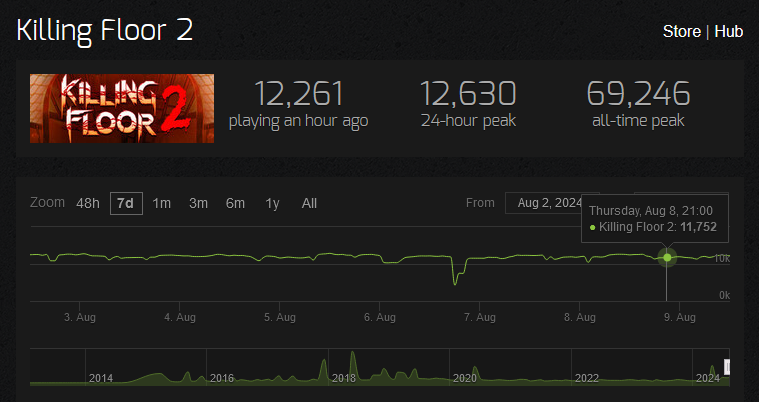
Seeing that, what an external observer should conclude? An observer not inclined to question the first impression and dig deeper, or, “a normie”, would conclude that there are 12K concurrent players and the game is doing pretty well. The servers are populated and the lobbies are full. Indeed, this is exactly what happens when the player counts are discussed on a heavily moderated Killing Floor subreddit:
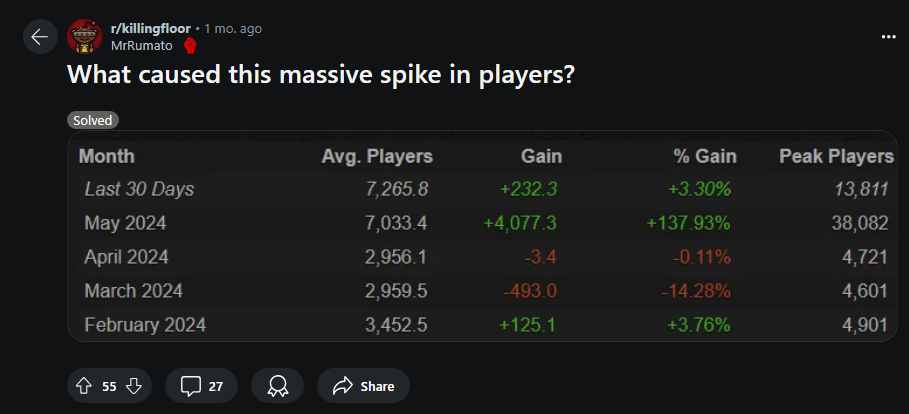
Of course, this spike in players was caused mostly by bots. But that’s not the answers this redditor gets:

Note how this poorly informed redditor tries to be ironic and funny about a thing he doesn’t even know how it works.
And so on:
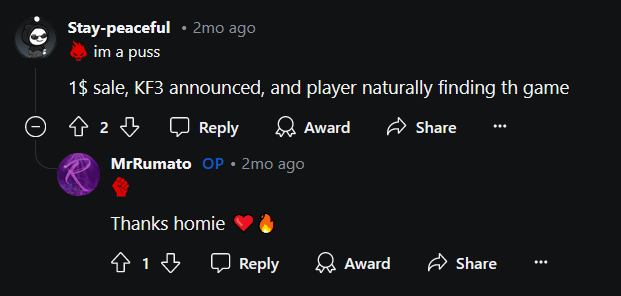


Another example:
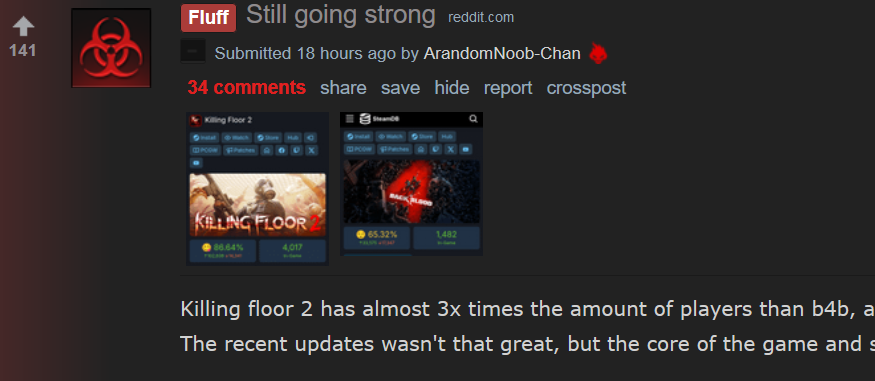
It does, indeed, report that KF2 has 3x times the amount of players more than Back 4 Blood. Too bad, 70-90% of them are farming bots. Amazingly, Back 4 Blood, for all the observed time, has been a more successful game in terms of player retention as measured by the Steam in-game concurrent player numbers.
Same story with the gaming media:
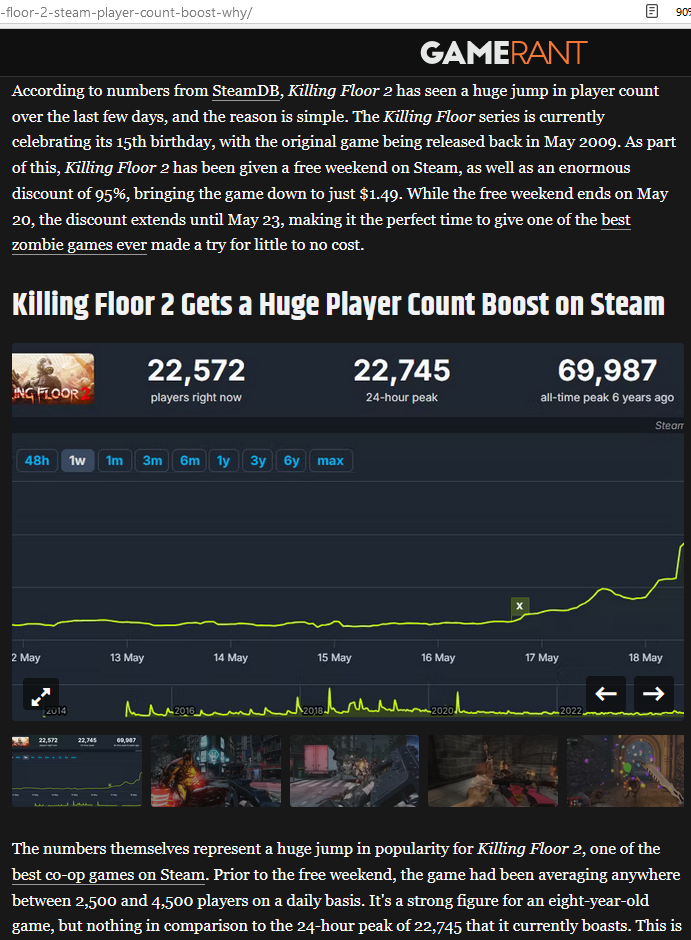
Whenever this topic is discussed almost anywhere there are no dissenting opinions can be found that question these numbers. It seems like it’s a widespread impression that Killing Floor 2 is a successful game, but this may not be entirely correct. This post seeks to change that impression.
Assessing the numbers of fake players
Farming bots for almost all purposes should be considered as fake players. They, obviously, cannot be played with. So, from a regular gamer perspective, the high concurrent in-game player numbers are misleading. A typical train of thought after seeing these numbers is that one can easily find an almost full lobby any time and join a game in any mode of play on any difficulty in any world region. The game is well alive and all sorts of lobbies are full of players. This is not the case. Although the PC platform (which is comprised of Steam and Epic game store customers because of the cross-play between the two) is the most popular for this game, it’s common to not being able to find a lobby with specific settings during off-peak hours in less populated regions, if a gamer doesn’t want to play on high ping (100+ ms) servers. One either has to start a lobby with their settings themselves, or play on high ping servers in a region that is currently prime time, or reduce the specificity of their wishes, such as giving up the desired difficulty, or game mode, or other server parameters.
The bots skew the popularity metric of the game as compared to other games. The video games media article quoted above refers to KF2 as “one of the best co-op games on Steam”. But by what exact metric it is one of the best? Consider the graphs and data below that show undeniably that KF2 is the worst performing game out of all similar co-op games on Steam, as measured by the “in-game” concurrent players number.
Naturally, such a player may start questioning the official player numbers, like in the screencap shared in the beginning of this article. Being the least moderated KF2 discussion board, “Steam Discussions” on occasion features such topics:
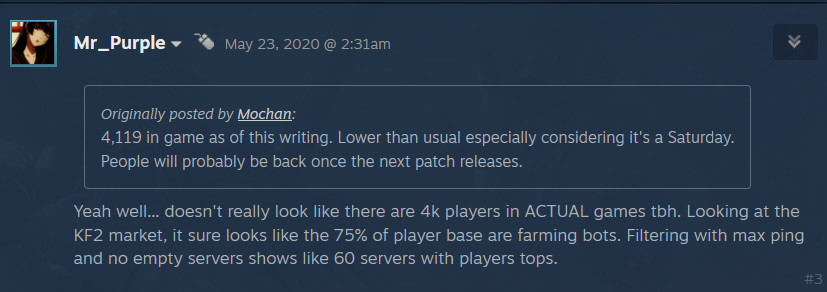
Note how this gamer didn’t trust the official player numbers and did some basic research into confirming it and found that, back in 2020 already, in their assessment 3/4 of the total concurrent in-game player numbers were likely farming bots. This figure of roughly 1K real players matches my analysis below rather well.

This player offers a possible explanation venue some of my critics have also offered — those players one cannot find on any servers are solo players, who play offline and their numbers count up to the totals we don’t see on any servers. This is very likely incorrect, as the solo player numbers in this game are very small. Most of the concurrent in-game player numbers are farming bots instead.
I’ve been collecting various observational data proving the thesis of this article and here would like to offer you an opportunity to learn everything first hand with full dataset shared and full transparency, so you can verify my findings and make your own evidence-based conclusions. Below I’m going to offer two ways to prove the fake players situation. The first of them is the irregular pattern of the function of the in-game players number over time. The second is a collection of direct measurements of the player numbers on all KF2 servers in the world spanning 1 year.
Daily/weekly/seasonal pattern analysis
Consider the fact that the online gamer population in the world isn’t uniformly spread across the planet surface and instead is concentrated in a few highly populated and highly Internet connected areas. While researching various material for one of the previous articles on this web site I’ve stumbled upon this nifty picture from Kaspersky Labs, showing the “heat map” of a certain malware botnet Kaspersky Labs was investigating. A number and density of bots in any malware botnet is a good proxy for the number of Internet connected PCs. Which, in its turn, is a good proxy for the number and density of KF2 gamers, because the Internet connected PC is a prerequisite for the KF2 gaming.
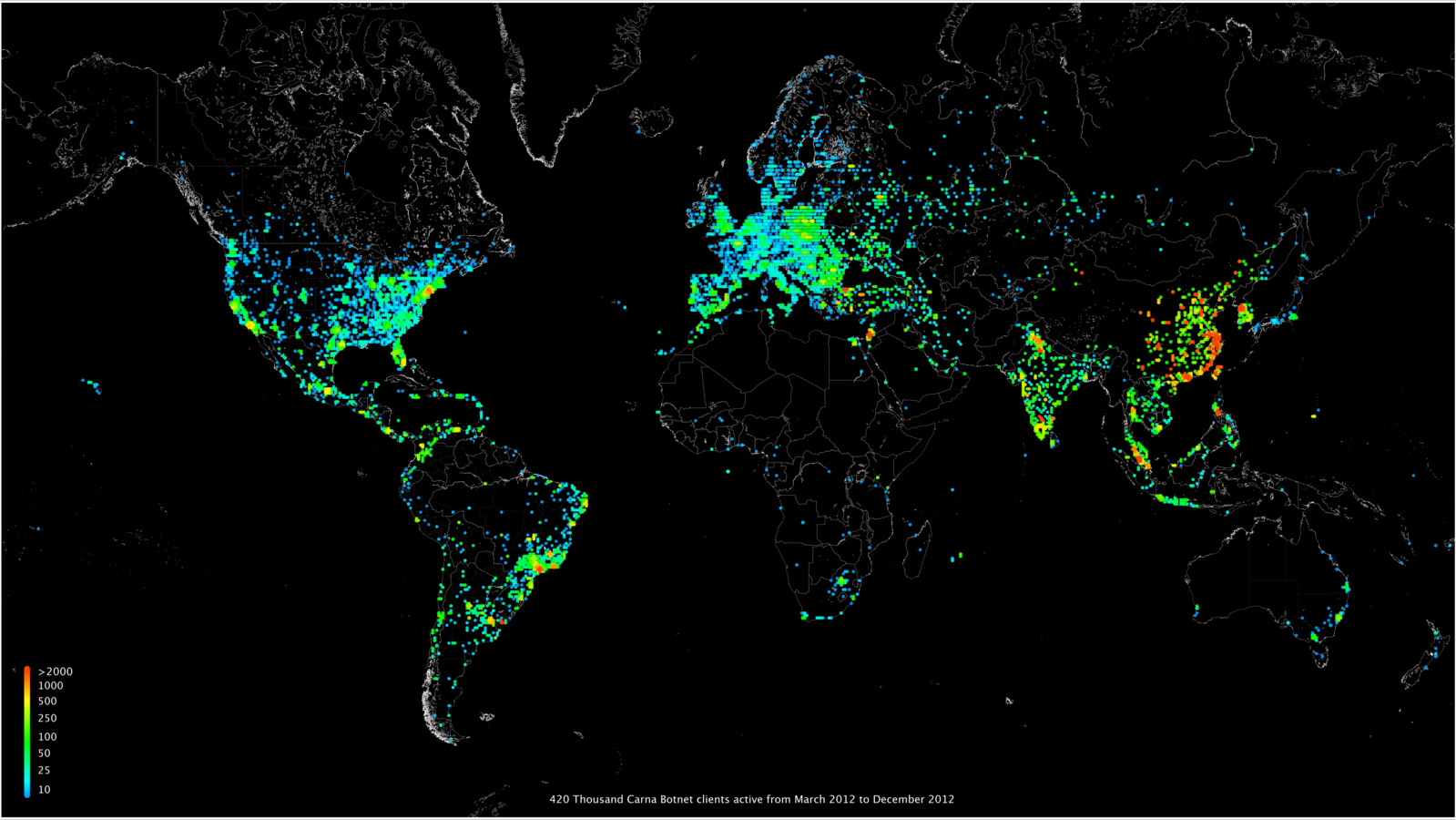
It’s easy to note here that Internet connected PCs cluster together in just a few timezones. There are three of them: Far East Asia and South Asia, Europe, and finally Americas, with huge gaps in between either due to oceans or spaces where there aren’t that many connected PCs can be found. As an example, according to this map, there are literally no Internet connected PCs in Afghanistan. Or, Canada or Russia are mostly barely populated frozen wastelands.
Considering that humans have to adhere to their biological clock cycle with staying awake and doing something during a day and sleeping at night, as well considering that many adults and adolescents have to spend a good share of their day time at work or school, the most likely time when they can play games is the evening of their time zone, with roughly 8PM-11PM time frame being the peak prime time. Another pattern is gamers play more during weekends as opposed to weekdays, because of not having to go to work or school. And, finally, game updates usually bring more gamers who are curious to check and try what new content was added. And these patterns can be easily observed in reality on how the in-game player number of almost any game on Steam changes with time. For that purpose services such as “Steam Charts” provide very handy graphs, like in these examples:
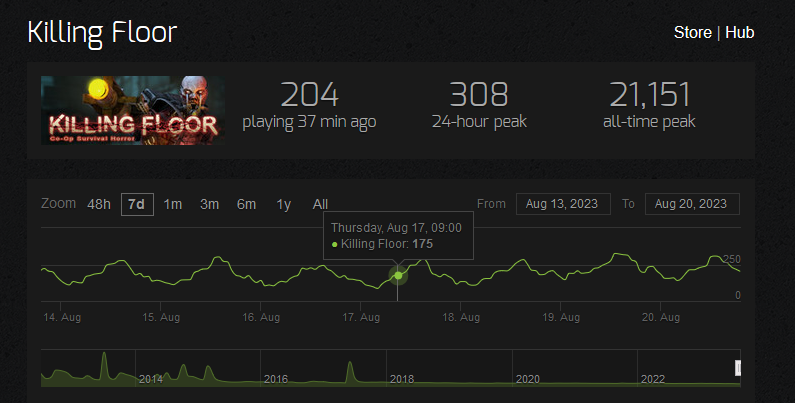
Note, how it grows to the peak (Asia prime time) and then goes down almost 3 times for the long Pacific Ocean hiatus.
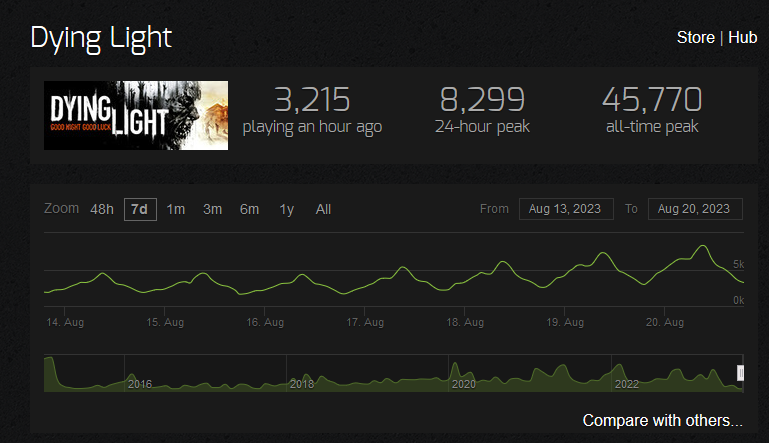
Similar story.
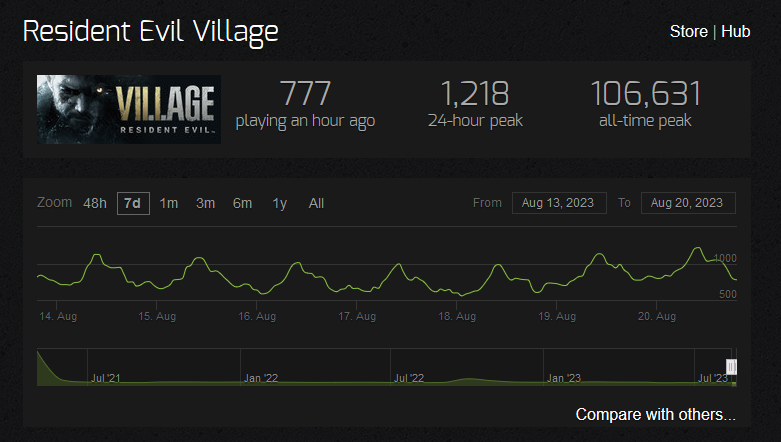
Again, the pronounced daily activity patterns.
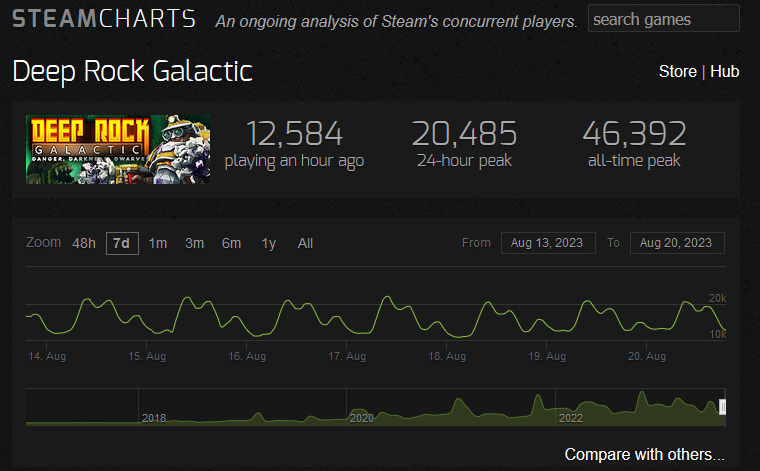
This last example from “Deep Rock Galactic” is even more interesting, because we see 3 pronounced peaks here, the highest is Asia prime time, the one a bit lower is Europe prime time and Americas prime time, after which there’s a long Pacific Ocean hiatus. The presence or absence of pronounced regional peaks is a result of multiple factors. To name a few: the more engaging the game is, the longer it takes to complete one match, the less pronounced the peaks are, because the gamers tend to play for longer time and stretch their contribution to the in-game concurrent players number. If a match lasts for, say, 30 minutes on average and playing 1 match is satisfactory enough, most gamers play 1 match and proceed to do other things in their lives. Another factor is the more popular the game is, the less noisy and less subjected to random variation the graph is, and you can easily see that DRG is a much more popular game than any other quoted before that, so, naturally, the patterns are more pronounced.
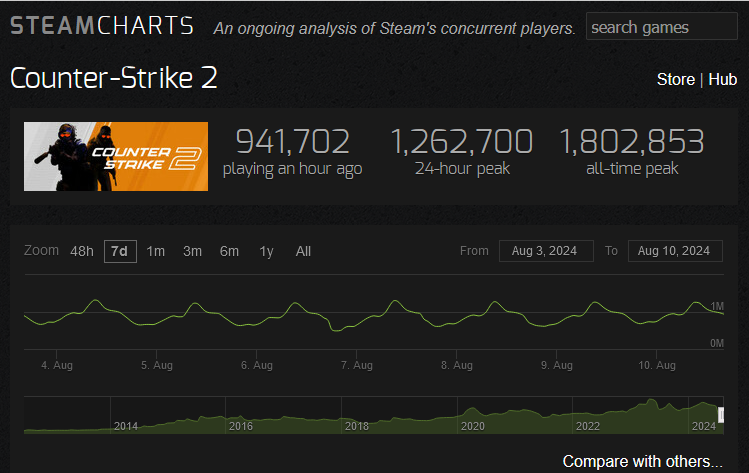
Same story.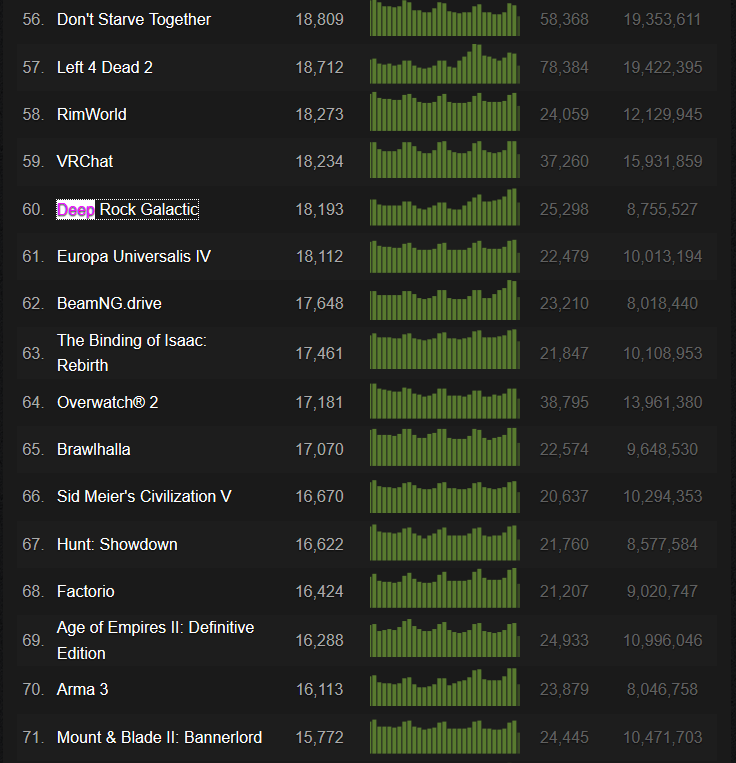
And, finally, on this chart above one can easily notice the weekend spike patterns, with 5 weekdays having lower gamer counts, while 2 weekend days having higher gamer counts. Another observation we can make here is most games on steam report honest in-game concurrent player numbers which conform to the daily and weekly patterns. But none of these patterns can be observed regarding KF2:
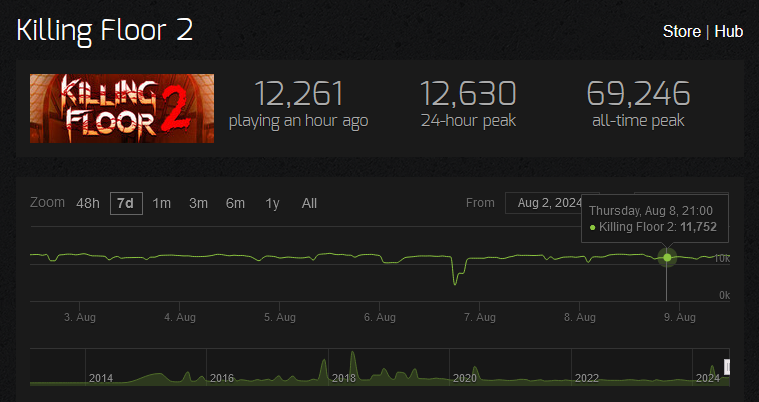
Why no daily pattern? Why no weekly pattern? This is because the bots are computers and, unlike humans, they can work 24/7 and don’t have to sleep, go to work or school and they never get tired of what they do.
The absence of any patterns in the in-game player numbers is quite a rare phenomenon that isn’t easy to find across other Steam games. However, I was able to identify 2 other games that exhibit very similar graphs, these are Team Fortress 2 and Payday 2. Consider these charts:
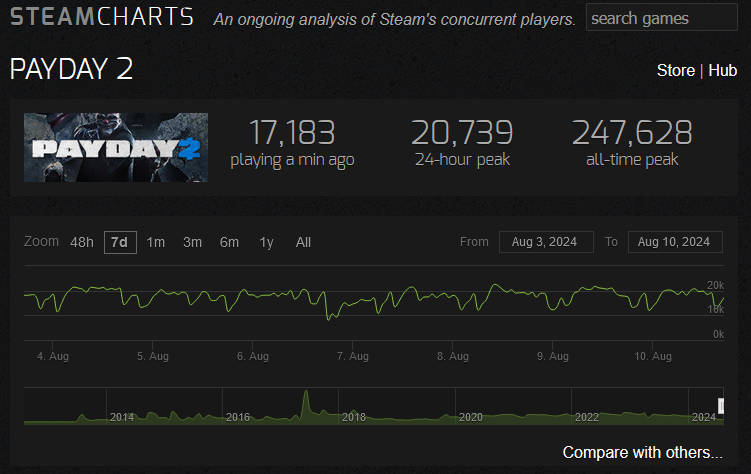
Note that there are no daily/weekly patterns here, although it’s not a flat line, the way KF2 graph is. There’s an explanation for this offered below.
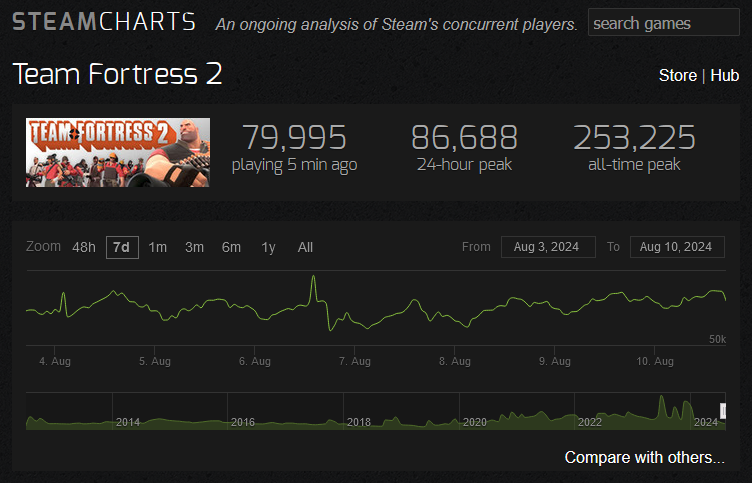
Here, if one squints, a daily pattern is noticeable, with recurring peaks during EU prime time and dips of the Pacific Ocean. However, the graph isn’t smooth as you would expect from a popular enough game to alleviate for random noise, such as DRG or CS2. What are these sudden surges and dips?
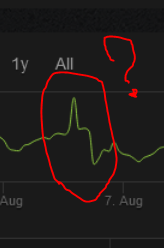
It becomes more clear if we recall that, after 2 mildly successful “SaveTF2” campaigns, the fans forced Valve, the company behind the TF2 game, to address the bot problem somewhat. While it’s easy to argue that these efforts were not enough and were very half-assed, they still managed to reduce the bot counts by tens of thousands. Here’s how a similar graph looked like 2 years ago:
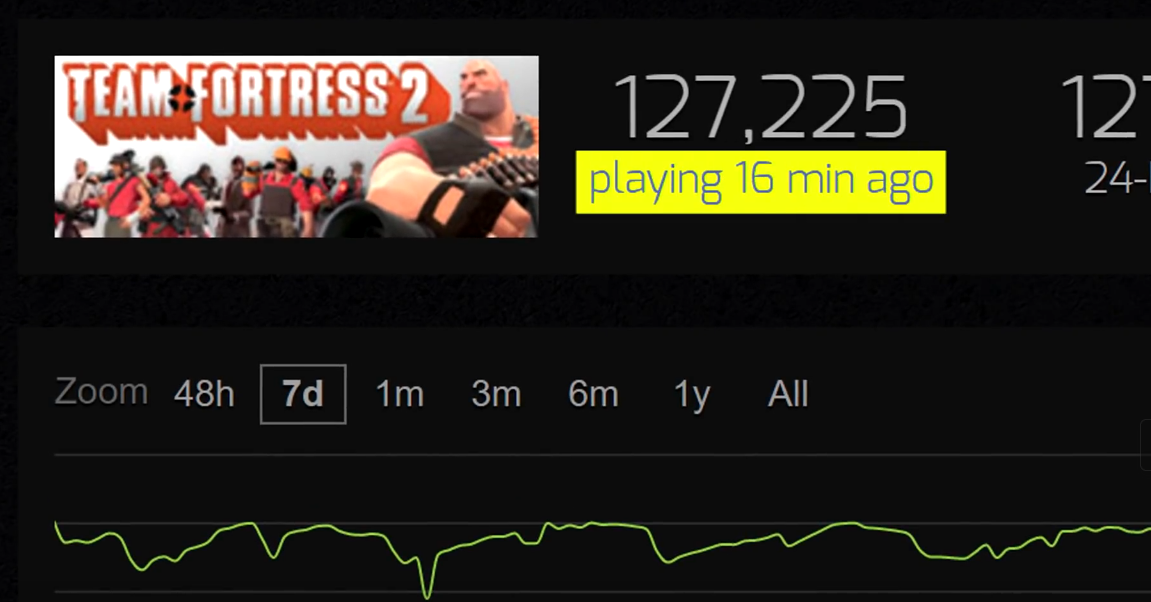
There’s no identifiable patterns here, but note that the number of players is >1.5 times higher. It’s very likely that these 47K players that are gone these days were the bots that Valve managed to root out. Naturally, when a significant share of the reported player numbers are real gamers, they introduce the daily and weekly patterns and the graph starts looking more sane.
Now, let’s discuss the sudden surges and dips on all the graphs pertaining to PD2, KF2 and TF2:
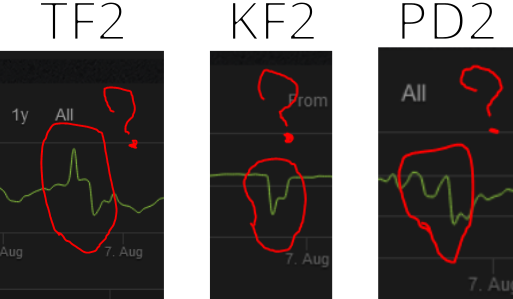
The explanation for these events, which are completely absent from any game chart with legitimate players — this thing just literally never happens to legit games — is the bot masters command big enough numbers of bots to make profound impact on the in-game player numbers. By shutting their army of bots down or restarting them for maintenance they make these charts produce huge surges or dips. If one single installation of ASF can maintain hundreds of bot instances and each installation is either dockerized, making it one instance per container, or virtualized, making it one instance per VM, an orchestrated restart of the containers or VMs in order to, say, update ASF or change the configuration, results in these surges and dips on the graph.
By measuring the number of players suddenly added or removed, we can assess the number of bots 1 bot master is in command of. This is because it’s unlikely that the botmasters coordinate their farm restarts with each other, each dip or surge means that a particular botmaster is working on their bot farm at the moment and mass restarts them either for updates or for picking up a new configuration. Through that we can tell that KF2 recently was blessed by the attention of a huge bot farm operator that commands roughly 7K bots. They alone contribute >50% to the total concurrent in-game players number. We also likely to have a few botmasters who command less numerous bot farms, but we likely have no more than about 4-5 of them total.
Payday 2 or Team Fortress 2, to the contrary, likely have more botmasters, because the dips and surges comprise only a small fraction of the total concurrent players number.
As it pertains to TF2, this situation is thoroughly documented in this video, which is worth reviewing as it resembles the KF2 situation very closely and is studied more thoroughly and for a longer time:
Now, why it’s PD2, TF2 and KF2? What these three have in common, besides being the second iteration in the appropriate franchise? They all feature the in-game random item drops that can be sold on a market. This randomized microtransactions thing, or MTX for short, was initially a feature of solely free-to-play games, such as Team Fortress 2, but, unfortunately, and to a significant gamers dismay, crept its way into paid games, such as KF2. From the botmaster’s perspective, the price of a game should be low enough to warrant investing in farming in it, ideally, free. This is why this farming bot plague initially started in TF2.
However, even paid games, if they are old enough, have their price typically reduced down to very small numbers. KF2 for a long time had the cost per copy of around $2 US dollars:
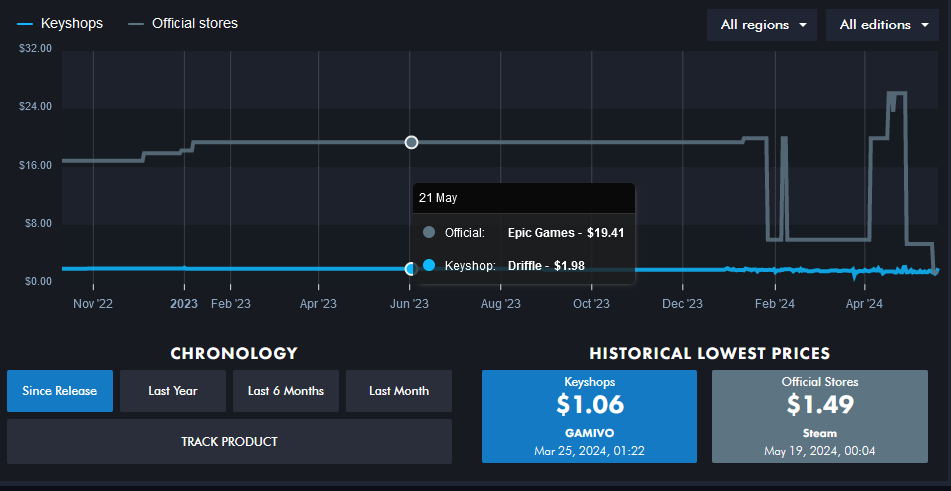
From here we can tell that $2 is low enough to make item drops and trading card farming in KF2 profitable enough. But in May of 2024, as the screencap above rightfully notes, TripWire Interactive went on a huge -95% sale, offering the game for a below $2 price tag for the first time. Depending on sales taxes it could go as low as ~$1.6. Combined with the free to play weekend event, this has brought a number of new players, but even more so bots! This was the exact time when this game got its largest bot master and its in-game concurrent players number went from ~3.5K on average to whopping 11K-12K on average. As I kept watching the numbers for this research, I managed to catch this moment live when the things were happening:
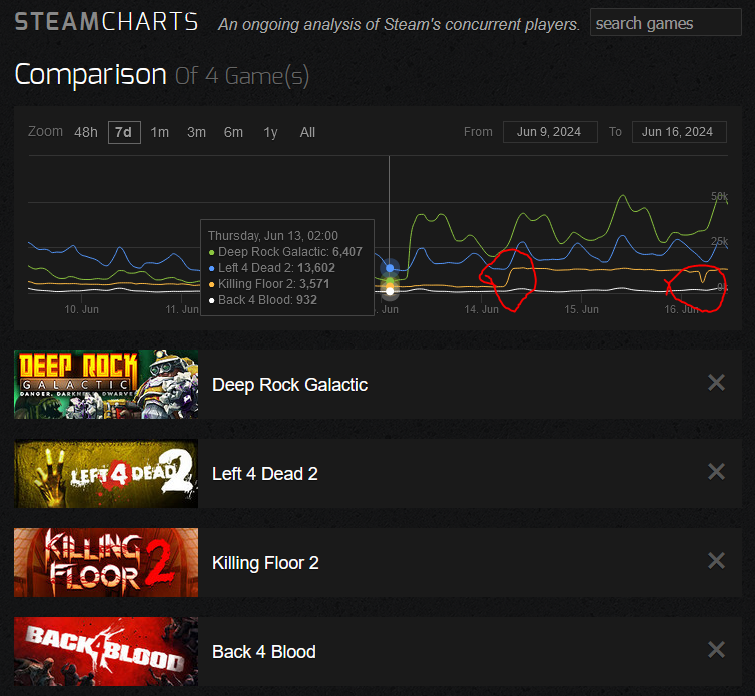
It’s a pretty loaded chart, let me unpack what’s going on here. It’s a “comparison” chart, showcasing 4 games in the same genre, “Deep Rock Galactic”, “Left 4 Dead 2”, “Killing Floor 2” and “Back 4 Blood”. Each game has a graph of its own color measuring its in-game concurrent players number over time on the same scale. Because the scale is the same, we can compare the relative popularity between different games.
This graph also captured the exact moment when a new KF2 bot master arrived at the scene at the highlighted area in the middle. On June 14th this actor added about 7K bots to KF2 which resulted in a major surge in the in-game player count which stays up until this very day.
This surge came just about 1 month after the unprecedented -95% sale on Steam, which hints that it took this particular bot master about a month to set up their bot farm. This also implies that, if they didn’t somehow manage to get these copies for free, it required them to invest $1.6×7,000=11.2K dollars into KF2 copies to get their operation going.
Another highlighted area on the right is a typical bot master maintenance activity, which likely is a result of the bot master changing configs of their ASF farm which requires a restart for all the ASF instances, so you get the graph going down to the lower number of players that then backs up to the same level it was before, because the amount of ASF instances that went down equals to the amount of ASF instances that get online after a restart. Such dips followed by an almost immediate surge back to where the graph line would have continued if it didn’t happen, is typically a robust tell that the bot master had to restart their farm to reapply the new configuration.
Tangentially, this graph also shows how a seasonal pattern looks like on the example of the “Deep Rock Galactic” game. As you can see here on the 13th of June 2024 the Danish game studio “Ghost Ship” launched a seasonal update for their game which brought a spike in the player numbers. The seasonal player numbers spikes though never look like the bot farm restart spikes, because the seasonal legitimate player spikes retain both daily and weekly use patterns as you can easily note on the green line graph, which follows the East Asia, Europe and Americas spikes each day every day.
This graph doesn’t imply though that we didn’t have a bots situation prior to June 14th, 2024. How many of the reported 3.5K players prior to that surge do you think are legitimate human players? Read on to find out. More similar graphs proving the point:

No game with legit player numbers on Steam suddenly loses 1/3 of its players who for whatever reason don’t come back for ~1.5 days and then suddenly return. No game with legit players on Steam has a pretty much flat graph signaling that the game players play it 24/7 without any daily/weekly patterns.
As you can see, both Dying Light and Back 4 Blood exhibit clearly pronounced daily patterns. KF2, to the contrary, is flatlined, no daily patterns.
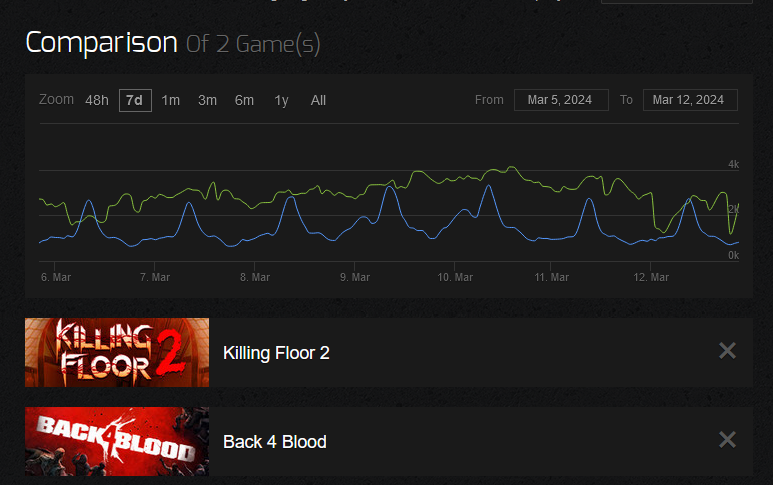
Although there are no daily patterns here, it’s a situation where the bots constituted roughly from 1/2 to 2/3 of the total player number, which means that the random nature of human players joining/leaving the games affects the graph to a larger degree, as compared to the times when the amount of bots is much higher. When the bots constitute a much higher share of the total player numbers the graph is usually more flat.
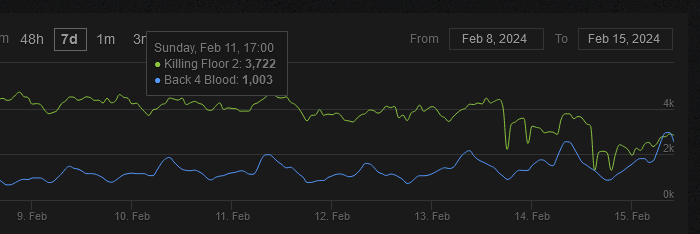
Once again: Back 4 Blood — daily patterns. Killing Floor 2 — no daily patterns and weird dips/surges, that are most likely explained by the bot farms being restarted and coming back online in a concerted effort.
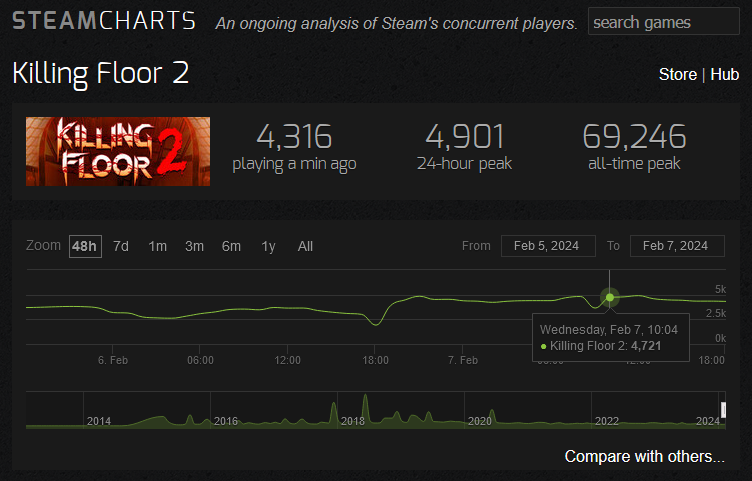
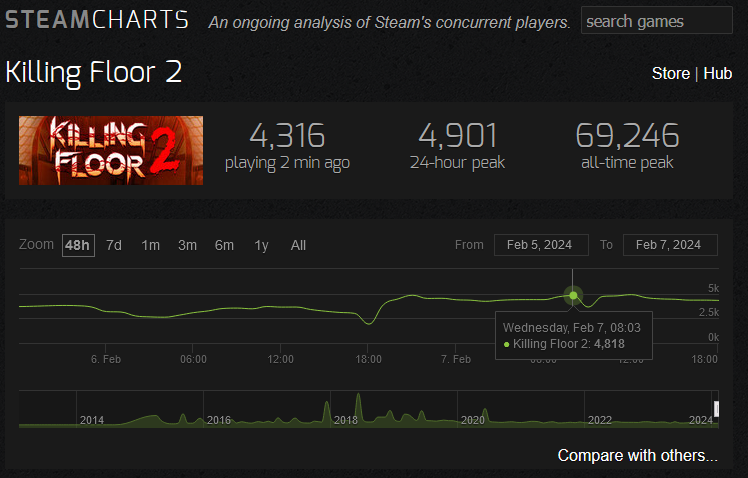
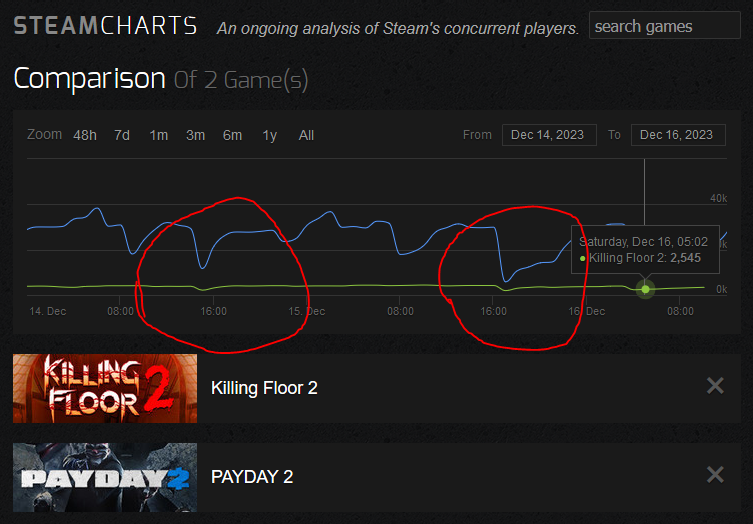
An interesting graph showing 2 of the bot infested games together, Payday 2 and Killing Floor 2. Interestingly, they seem to dip at the same time, as if it was the same bot master whose bot farms were rebooted at the same time. Which is what naturally happens, when several bot farms are operated on a single virtual machine and the VM is rebooted.
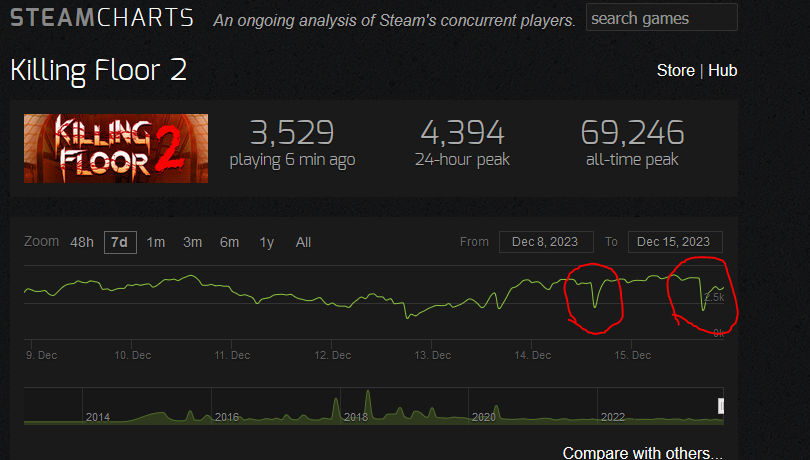
More dips/surges resembling the “reboot the VM” pattern of a bot farm.
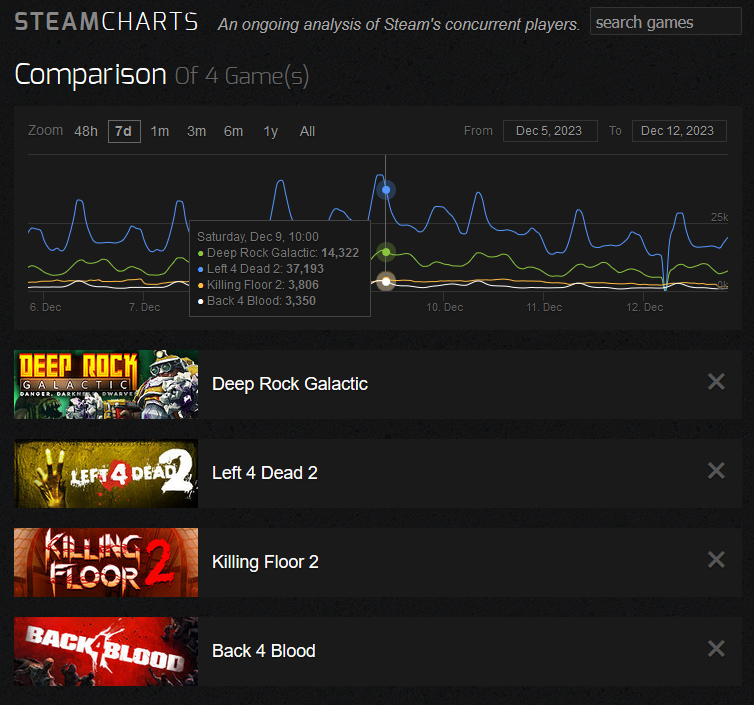
DRG, B4B, L4D2 — all have daily patterns. KF2 doesn’t.

WH40K: Darktide, DL, WWZ — all have daily patterns. KF2 doesn’t. It’s also interesting to note how WH40K: Darktide is a mainly European game, with both Asia and Americas rivaling each other in player numbers, while WWZ and DL are games dominated mainly by Asian players, as the highest peaks are during the Asia prime time.
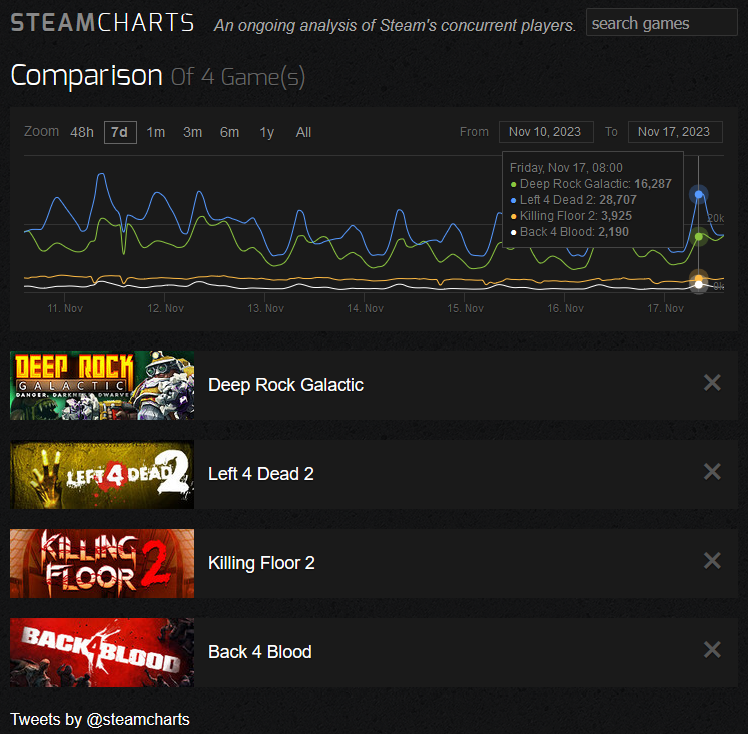
DRG, B4B, L4D2 — all have daily patterns. KF2 doesn’t.
DRG, L4D2 — all have daily patterns. KF2 doesn’t.
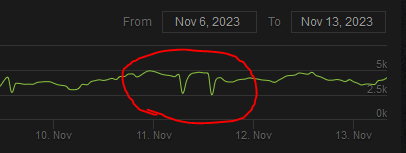
More patterns resembling a bot farm VM restart, but none of the human player daily patterns.
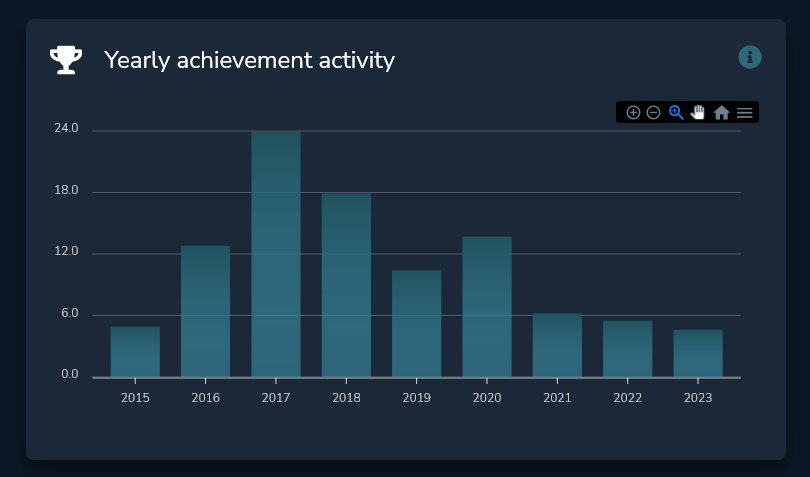
A yearly achievement activity of KF2. As you can see the game’s popularity clearly goes downhill after peaking in 2017 with a small resurgence due to the COVID-19 lockdowns in 2020. But one cannot tell that from the in-game player numbers! The in-game player numbers were hanging around 2.5K-3.5K players for a long time, until hitting ~11-12K in Summer 2024 with the arrival of the biggest game bot master in KF2 history. How could it be that the players play more than ever, but don’t score any achievements? This is because they are bots. They don’t play the game, so they don’t score any achievements.
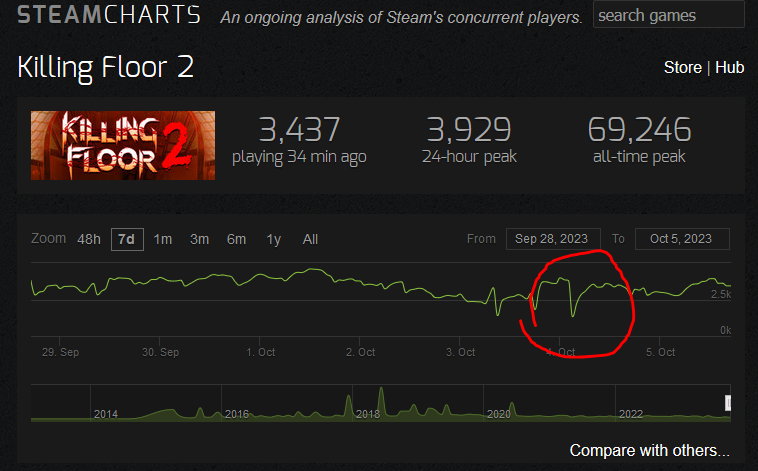
More bot-like spikes and dips.
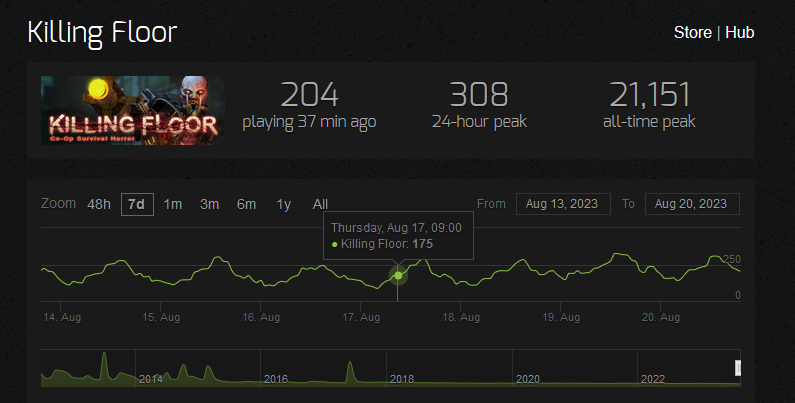
Daily patterns of KF2 predecessor. Mere 250 concurrent players on average, but they are fair.
Online player number analysis
The Steam in-game concurrent players number is comprised of all instances of Steam client, either official or not, that report back to the Steam backend API that a certain game is running. The backend API system just trusts the client’s report, as long as the Steam account associated with it isn’t banned or somehow otherwise prohibited from reporting this data. As it was shown above, this status can be manipulated easily and almost for free. Is there a way to filter out all that garbage and keep only legitimate human players in the game? Here I propose a methodology on how to achieve that as well as 1 year long observational data relying on that methodology.
The methodology isn’t new and is something I have borrowed from the TF2 community on teamwork.tf who maintain a way to get the online player numbers by querying the so-called query port of every TF2 server that advertises itself to Steam and, thus, can be found in the Steam browser. Such query to the Steam port query is anonymous and the server responds with various useful data, such as the amount of max players on the server, the number of player slots already occupied, which map is currently played, difficulty and so on.
I’ve been relying on the built-in Steam browser during the first year of observations and am about to change that to relying on a Python script. But, to reproduce it manually, here are the simple steps to do it.
- Obtain and install the old steam client. This is needed because the new Steam UI introduced in 2023 doesn’t report the total server count. The new Steam UI being bad and of reduced functionality is one of the reasons I’m changing it from the manual approach to a scripted one. A working approach is described here.
- Go to Library, View, Servers. Configure the Steam server browser filter as it’s shown on this screencap, select the game to be “Killing Floor 2”, latency less than 600 and so on. If your plan is to take recurring observations, you have to do them at exactly the same time of the day and week to account for the daily and weekly patterns, I was taking my measurements at ~12:00 PM CST/CDT.
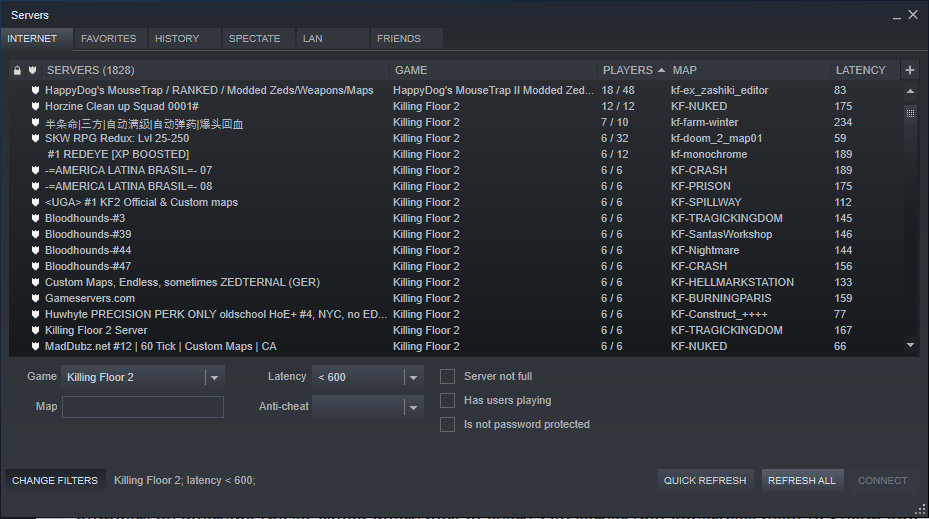
- Calculate manually the players on servers that allow for >6 players total. E.g. on this screencap, you would add 18+12 and omit that Chinese server with 7/10 players because it’s fraudulent. If it wasn’t you would add 7 as well. This gives you the total number of online players on >6 player servers. Easy enough.
- Then ensure your “favorites” list is empty and, while holding shift button, select the whole range of servers with exactly 6 players on them, right click on the selected area and click on “add server to favorites”. This will add all selected servers to the favorited servers list. Note that on the screenshot below 2 first servers with 6 players on them weren’t selected, but you should.
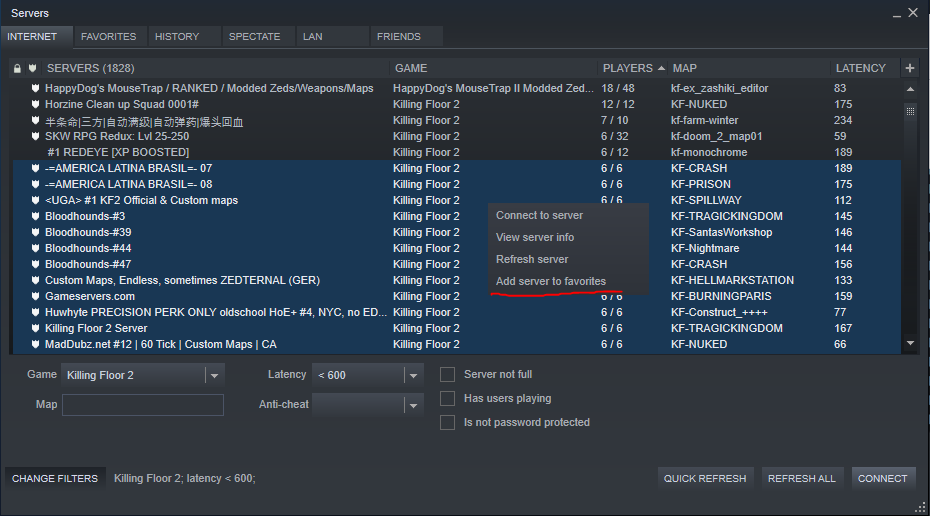
- Switch to the “favorites” tab and observe the number of servers in the list.
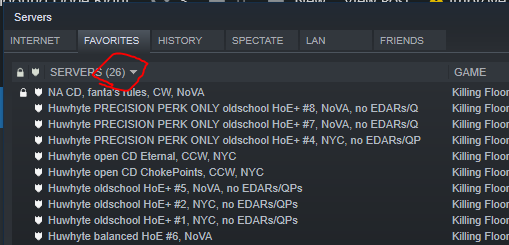
- Multiply the number of servers shown in this tab by 6 to arrive at the total number of online players on the servers that are full 6 out of 6 available slots.
- Repeat the exercise for all other servers with less number of players, not forgetting to remove the servers from the favorites after each exercise. This will give you the total number of online players on servers that are populated currently by 5, 4, 3, 2, 1 players appropriately.
- Sum everything up and arrive at the total online players that have joined any KF2 servers in the world, similar to the table below.
| players on >6p | exactly 6p | 5p | 4p | 3p | 2p | 1p | totals online: | totals according to steam | Difference, # | Difference, % | ||
| 08/07/2023 12:00 PM CDT | # populated servers | 6 | 55 | 17 | 21 | 34 | 53 | 47 | 233 | |||
| total players | 76 | 330 | 85 | 84 | 102 | 106 | 47 | 830 | 2433 | 1603 | 65.89 | |
| 08/10/2023 12:00 PM CDT | # populated servers | 3 | 37 | 16 | 17 | 33 | 49 | 59 | 214 | |||
| total players | 44 | 222 | 80 | 68 | 99 | 98 | 59 | 670 | 1976 | 1306 | 66.09 | |
| 08/13/2023 12:00 PM CDT | # populated servers | 5 | 57 | 24 | 26 | 41 | 74 | 69 | 296 | |||
| total players | 71 | 342 | 120 | 104 | 123 | 148 | 69 | 977 | 2900 | 1923 | 66.31 | |
| 08/17/2023 12:00 PM CDT | # populated servers | 3 | 40 | 12 | 19 | 36 | 62 | 49 | 221 | |||
| total players | 42 | 240 | 60 | 76 | 108 | 124 | 49 | 699 | 3589 | 2890 | 80.52 | |
| 09/03/2023 11:15 AM CDT | # populated servers | 9 | 151 | 34 | 43 | 102 | 162 | 98 | 599 | |||
| total players | 131 | 906 | 170 | 172 | 306 | 324 | 98 | 2107 | 5203 | 3096 | 59.50 | |
| 10/01/2023 11:15 AM CDT | # populated servers | 10 | 78 | 23 | 33 | 46 | 109 | 93 | 392 | |||
| total players | 121 | 468 | 115 | 132 | 138 | 218 | 93 | 1285 | 4441 | 3156 | 71.07 | |
| 11/5/2023 2:52PM CST | # populated servers | 5 | 107 | 33 | 58 | 73 | 148 | 79 | 503 | |||
| total players | 64 | 642 | 165 | 232 | 219 | 296 | 79 | 1697 | 5397 | 3700 | 68.56 | |
| 12/3/2023 12:30PM CST | # populated servers | 3 | 76 | 26 | 28 | 50 | 90 | 84 | 357 | |||
| total players | 60 | 456 | 130 | 112 | 150 | 180 | 84 | 1172 | 4073 | 2901 | 71.23 | |
| 12/31/2023 12:00PM CST | # populated servers | 5 | 62 | 29 | 26 | 40 | 89 | 76 | 327 | |||
| total players | 77 | 372 | 145 | 104 | 120 | 178 | 76 | 1072 | 4162 | 3090 | 74.24 | |
| 1/7/2023 1:29PM CST | # populated servers | 6 | 74 | 26 | 41 | 66 | 103 | 61 | 377 | |||
| total players | 94 | 444 | 130 | 164 | 198 | 206 | 61 | 1297 | 4072 | 2775 | 68.15 | |
| 3/17/2024 12:30PM CDT | # populated servers | 7 | 51 | 26 | 22 | 51 | 96 | 47 | 300 | |||
| total players | 98 | 306 | 130 | 88 | 153 | 192 | 47 | 1014 | 3597 | 2583 | 71.81 | |
| 4/14/2024 12:30PM CDT | # populated servers | 5 | 47 | 20 | 25 | 42 | 65 | 77 | 281 | |||
| total players | 63 | 282 | 100 | 100 | 126 | 130 | 77 | 878 | 3045 | 2167 | 71.17 | |
| 5/19/2024 12:00PM CDT | # populated servers | 28 | 678 | 121 | 129 | 194 | 323 | 134 | 1607 | |||
| total players | 361 | 2712 | 484 | 516 | 582 | 646 | 134 | 5435 | 36166 | 30731 | 84.97 | |
| 5/26/2024 5:00PM CDT | # populated servers | 9 | 207 | 62 | 87 | 125 | 290 | 125 | 905 | |||
| total players | 100 | 828 | 248 | 348 | 375 | 580 | 125 | 2604 | 6642 | 4038 | 60.79 | |
| 6/23/2024 1:30PM CDT | # populated servers | 6 | 74 | 35 | 38 | 58 | 133 | 86 | 430 | |||
| total players | 85 | 296 | 140 | 152 | 174 | 266 | 86 | 1199 | 11558 | 10359 | 89.63 | |
| 7/14/2024 2:20PM CDT | # populated servers | 7 | 80 | 38 | 44 | 75 | 126 | 84 | 454 | |||
| total players | 86 | 320 | 152 | 176 | 225 | 252 | 84 | 1295 | 11902 | 10607 | 89.12 |
If you want to crunch the numbers yourself, you can find the CSV file with the dataset here, to save time on scraping the numbers from the HTML page.
The table is self-explanatory, but if needed, here it is. Let’s take the last table entry as an example for explanation. 7/14/2024 2:20 PM CDT is when the measurement was taken. Kind of 2 hours 20 minutes later than I should have taken it, so feel free to discard such measurements as 2:20 PM CDT is close to EU prime time and thus has a bit more players. On the other hand it was shortly after the free weekend and -95% discount so the leftovers are still hanging around, so the picture is skewed anyways. Then the player calculations go. E.g. at the time there were 80 servers total with 6 players on them which translates to 320 players online playing on full 6 player servers, and so on. In the end we get 454 servers with any players on them and 1,295 players online total. This is a number that is very close to the concurrent human player numbers in this game and the only thing this doesn’t account for is solo “offline” players. Compare this number to the reported by Steam in-game player number of 11,902. Almost 90% of these are bots. You can’t play with them. You can’t see them on any servers. For all purposes these are fake players. The real number of human players in KF2 hovers around 1K in-game concurrent players total, depending on a season. During events, such as free-to-play weekends or discounts, it goes temporarily up to ~5K players, but then it gets back to 1K in just a few months. This situation likely lasts for years and is unlikely to change.
Here’s a useful graph showing the real player numbers and fake steam in-game player numbers changing over time over the last year:
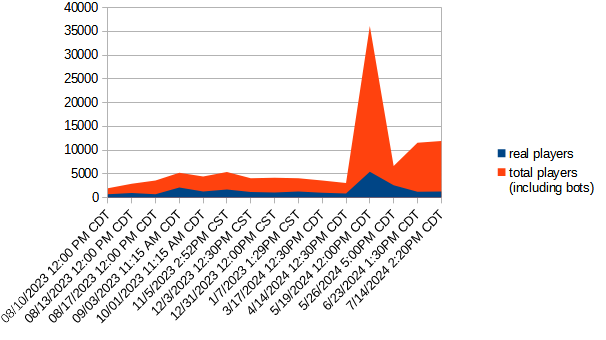
The thin blue line is the real online players. The orange thick line is the fake players, most likely farming bots, that complement the real player numbers up to the total in-game concurrent player count, as reported by Steam. Simple observations: the online real players number hovers around 1K with the exception of a free & discounted weekend, where the real player number goes as high as 5K, only to get back to the usual 1K players in a few months. Total player numbers, which include fake players, have been hovering around 3,5K-5K with a huge spike up to 36K total during a free to play weekend.
Note, that this method DOES count “Epic Game Store” or EGS players, while Steam in-game player count doesn’t. This is because the EGS players play, effectively, on Steam-distributed KF2 server software and contribute to the online player count. Yet, even with that small surplus, the online players count is multiple times less than what’s reported by the Steam in-game player counter. Here’s an example of how EGS players are reported by the “game query” port on KF2 game servers which proves that EGS players are counted towards online players on KF2 servers:
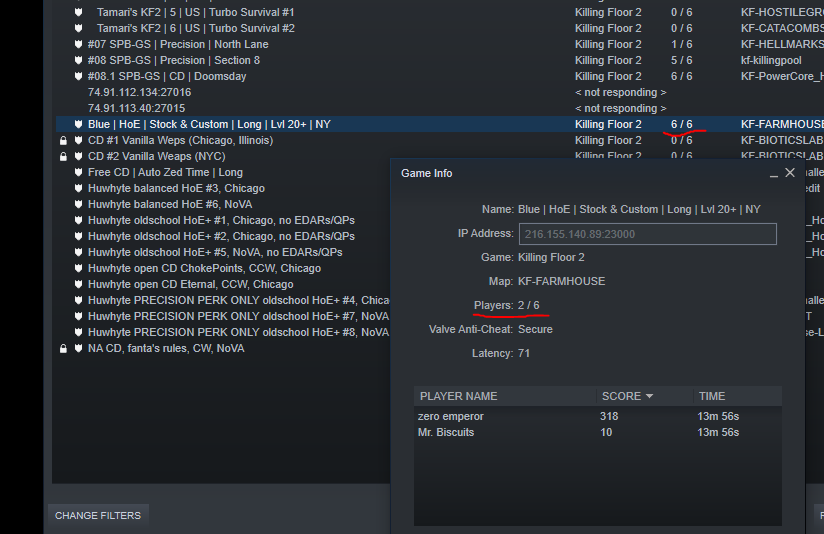
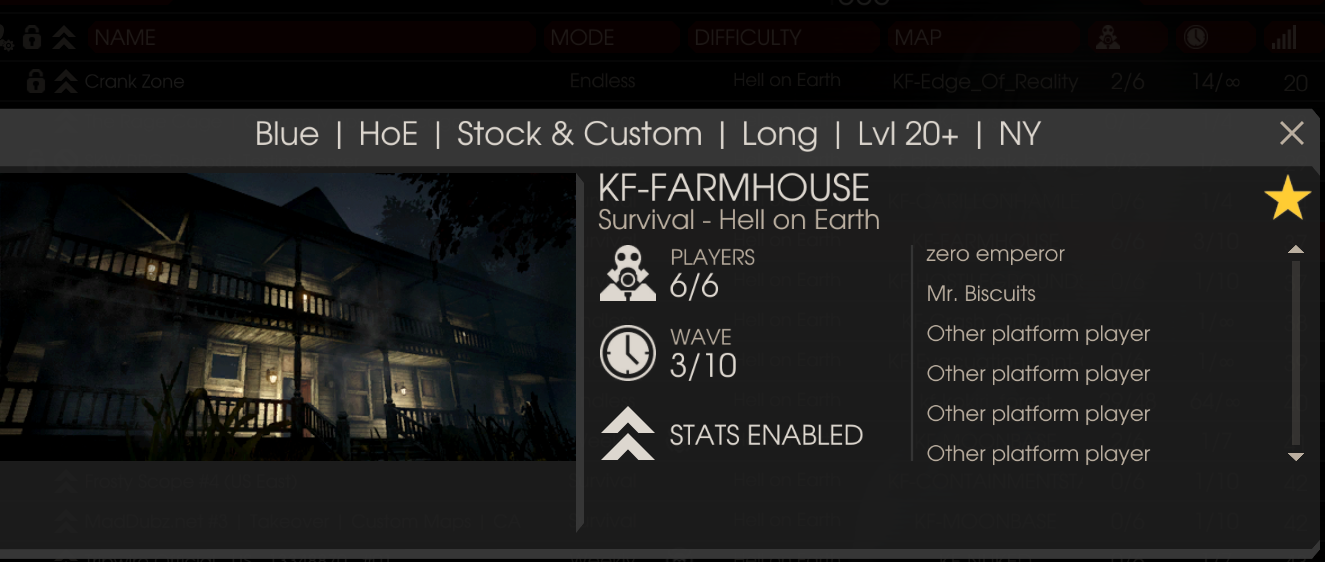
The sad reality of Killing Floor 2, according to the real player numbers, is it’s one of THE LEAST popular games in the genre. It’s mostly a dead game. Not only is it almost dead now, it was probably was like that since its launch and there’s limited evidence that most players were bots dating back to as far as 2019 and 2020. Almost every other game in this genre, including such titles as Back 4 Blood, Deep Rock Galactic, Left 4 Dead 2, Dying Light, Dying Light 2, Payday 2, Warhammer 40K: Darktide, — all outcompete Killing Floor 2 and by quite a lot, including titles with release dates earlier than that of KF2. The only title that hangs at roughly the same level is Back 4 Blood, which is largely considered as a failed game with “mixed” player reviews. Amazingly, KF2 maintains the concurrent player numbers that are not much higher than the numbers of the original Killing Floor. If it was truly “one of the best zombie games ever made” it surely wouldn’t end up at the bottom, would it? This result could very well be an outcome of the Tripwire Interactive’s decision to sideline the founding father of the franchise Alex Quick from directing the game and progressively swerving from the gritty and rusty post-apocalypse survival horror atmosphere into the glossy shiny scifi fortnitized childish atmosphere. This is not what the fans have been asking the studio to work on repeatedly, so it’s a natural outcome of the studio failing to maintain a coherent vision of the game.

Could very well be that through quite a long history of various anti-gamer TWI’s actions a good share of gamers decided to move on to better games.
What about solo “offline” players?
Since I’ve been conducting this research for a year, I’ve got a number of objections and criticisms and here I’d like to address some of them, at least to a degree. One of such objections is the solo “offline” players cannot be found on any online servers and therefore constitute a number of players that isn’t accounted for by the research into the real player numbers.
I have a few arguments partially addressing this objection.
1. This is a multiplayer game most and foremost, it is designed as such and is barely balanced for the single player experience. I have 6K+ hours in this game and consider myself an experienced solo player who enjoys the solo play as well, yet, even for me the solo play is a small fraction of my time in this game, maybe about 5% or so. Almost none of my online friends, most of which have thousands of hours in, with just a few exceptions, ever play this game solo. EVER. It simply cannot be that the solo offline players outnumber the online players 7:1 or 9:1, as the fake player/real player ratios suggest.
But I can provide a rough estimation of the amount of players who don’t mind playing offline solo. This is based on the idea that, roughly, the share of players who don’t mind starting playing solo on online game servers somewhat closely matches the share of players who play completely “offline” solo. As it’s easy to assess from the table above, the share of players on 1p servers hovers in the vicinity of 5% of the total real player base. Sometimes it goes as low as 2.45% of the total real player base, but never higher than 8.80%. So, I can just concede that the ~1K average number of the concurrent players I’ve discovered here is higher by 5%, which is going to increase it by mere 50 players to 1050, which is in the vicinity of the margin of the measurement error here and doesn’t change much.
2. If the solo “offline” players contributed that much to the total in-game player numbers as reported by Steam, they would naturally conform to the daily/weekly/seasonal patterns, just because they are humans, who have to sleep, work, study, get interested by seasonal events and so on. But it’s easy to observe that it’s not the case, because the in-game players over time graph of KF2 doesn’t conform to these patterns.
3. Keep in mind, as I mentioned before, that while the direct online player counting doesn’t include solo “offline” player numbers, it DOES include EGS players, which aren’t counted by the in-game steam counter. Could very well be that the “offline” solo players number is lower than the EGS players number and, therefore, all online players number calculated relying on this methodology, overestimates the real steam player numbers including the “offline” solo players, just because of the EGS contributions. While the EGS players numbers are small, they are probably >5% “offline” solo players.
Other possible explanations
While I do think that the farming/trading bots is the most likely explanation, mostly because this issue is also observed in all lootbox/MTX infested games, such as Payday 2 and Team Fortress 2, which makes a pattern, I cannot rule out other explanations. And here’s a pretty wild one.
It is known that Tripwire Interactive was sold by its owners to “Embracer Group AB” in 2022 for “hundreds of millions”. Here’s how the former CEO and President of Tripwire Interactive reported on it on Twitter:

The context of this tweet is Gibson responding to someone who has donated $250 to the “Lilith Fund”, which is some kind of foundation to promote abortions and Gibson counters it by donating some of his fortune for the anti-abortionist cause.
Killing Floor 2 is the main cash cow game for the studio, the main source of income. Their Red Orchestra and Rising Storm games are old and don’t have the lootboxes. Their publishing division works on publishing even more niche games than the Killing Floor franchise with pathetically small player bases, such as Deceive Inc. or Maneather:
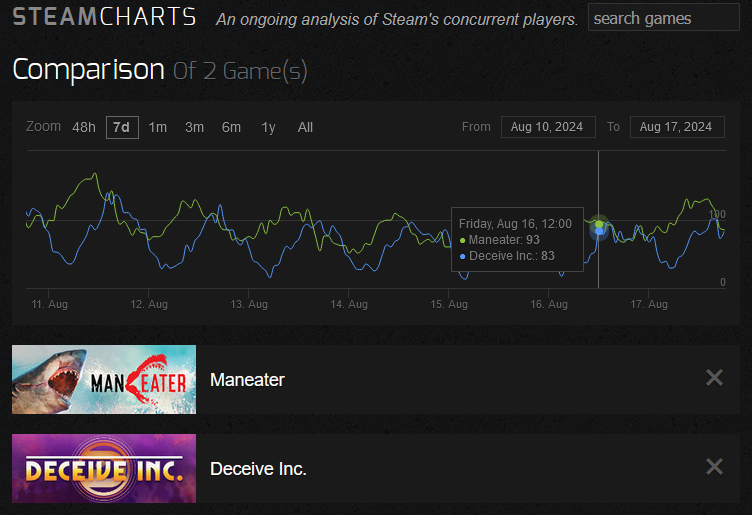
Killing Floor games are their best sellers and these games also feature a very long list of DLC and microtransactions, including RNG-based lootboxes.
It’s not uncommon for businesses to manipulate vital performance metrics in order to make their products and services look better than they are in reality. Which is especially important right before the sale of the company. Say, if your player numbers were good, wouldn’t you bring it up at the negotiations table as a bargaining tactic? But, if your player numbers weren’t as good, would you inflate them artificially? Or, at least, pretend that you aren’t aware of the bots infesting your game and advertise those player numbers as something real?
Although honest people would not, the history provides plenty of examples where the profiteers would. Fake customer reviews, artificially inflated user numbers, fake ratings, Google page rank algorithm exploited to get one’s web sites to the top of the search engine’s output are commonly encountered tactics where participants have to compete with each other for the top spot and nobody holds them accountable if they game the system. It’s sort of a cheating and people have been engaging in all sorts of cheating since the dawn of civilization.
As a not directly related example, here’s what Amazon has to say about the fake customer reviews. Note, they wouldn’t have to put out there such a warning if this problem wasn’t widespread:
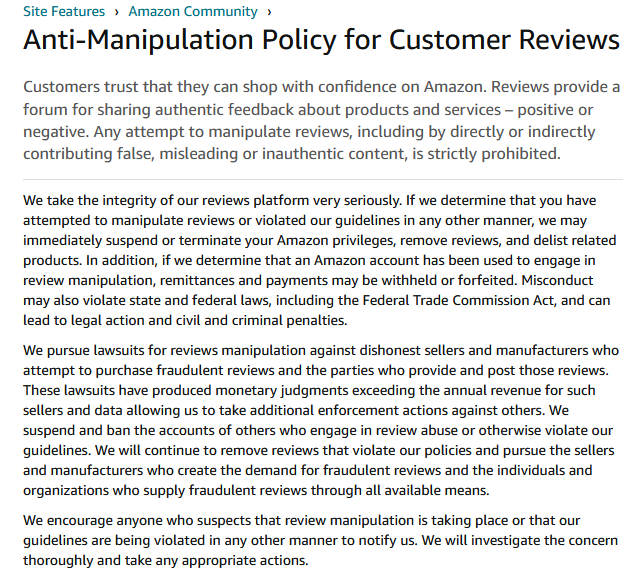
Amazon does it, because of the care for their reputation. If they didn’t fight fake reviews vigorously, their customers would eventually figure this out, stop trusting their customer reviews, and stop trusting the platform as a whole and their competitors, such as Walmart, would take over a share of their market.
Or, a closer hit to the video gaming industry, this testimony from one of the “World of Warcraft” developers, shared in his tweet:

This is also something that Embracer Group AB, one would think, may be interested in. They buy and sell game studios all the time and one would think they would have a dedicated team of investigators (or seek services of people like myself) who would put the reported numbers under some scrutiny before buying a gamedev studio. As another example, in a somewhat similar case, when Elon Musk was buying Twitter, he hired an external auditing firm to verify Twitter’s claims about their user base. Unsurprisingly, the Twitter user base numbers were brought up at the negotiation table and Elon wanted to make sure he’s not duped into buying a platform infested by bots. Naturally, the auditing firm has found that a huge share of the Twitter accounts are actually bots:
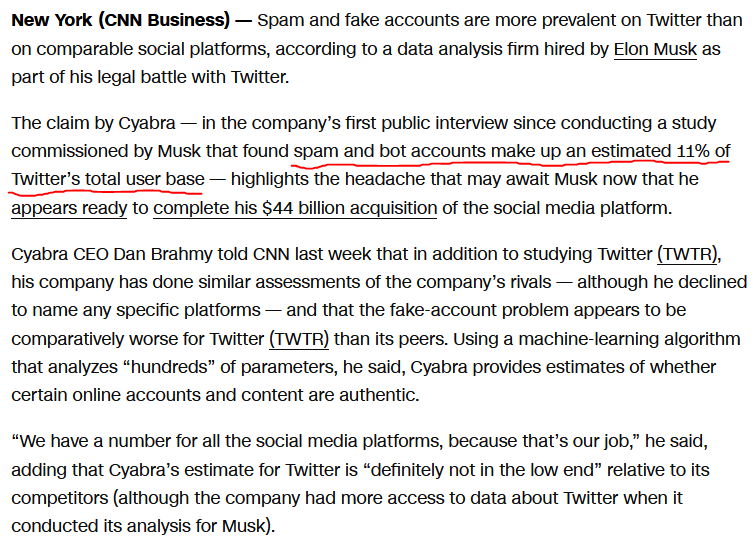
Let’s make some basic calculations. The total number of Twitter accounts at the time was estimated to be at 1.3 billion. Out of which 450 million were monthly active users, and the number of concurrent users is necessarily even smaller than that. 11% out of 1.3 billion is a huge number of 143 million accounts. It could very well be, if we narrow it down to the concurrent users, roughly half of all concurrent Twitter users are bots, or, at least, the number of bots on Twitter is of the same magnitude as the number of concurrent human users. I bet that this finding allowed Elon Musk to have leverage at the negotiation table and may even reduce the price the Twitter executives asked for. But when selling and buying game studios, not only the total number of copies of the main cash cow game sold matters. This would be the only number brought up if the game was selling for an upfront price tag without DLC or MTX involved. But when we talk about a long retention type of games, such as KF2 or Payday 2 or Deep Rock Galactic or Left 4 Dead 2, what also matters is the concurrent in-game player numbers, as these are the players who keep investing into the game they consistently play by buying DLC, by buying skins and gambling the lootboxes. The question is, did Lars Wingefors, the CEO of Embracer Group AB, do his due diligence research and did he conduct an investigation into what share of the in-game players are actually bots, regardless of who the bot masters of these bots are?
This hypothesis doesn’t contradict and actually complements the theory about the intentions of these bot farm masters. I’d like to bring up the fact showing that having the game infested by bots is mutually beneficial both for the bot masters and the game studios, as long as they can keep it secret. Here’s a screenshot of such an offer from a bot master to a gamedev:
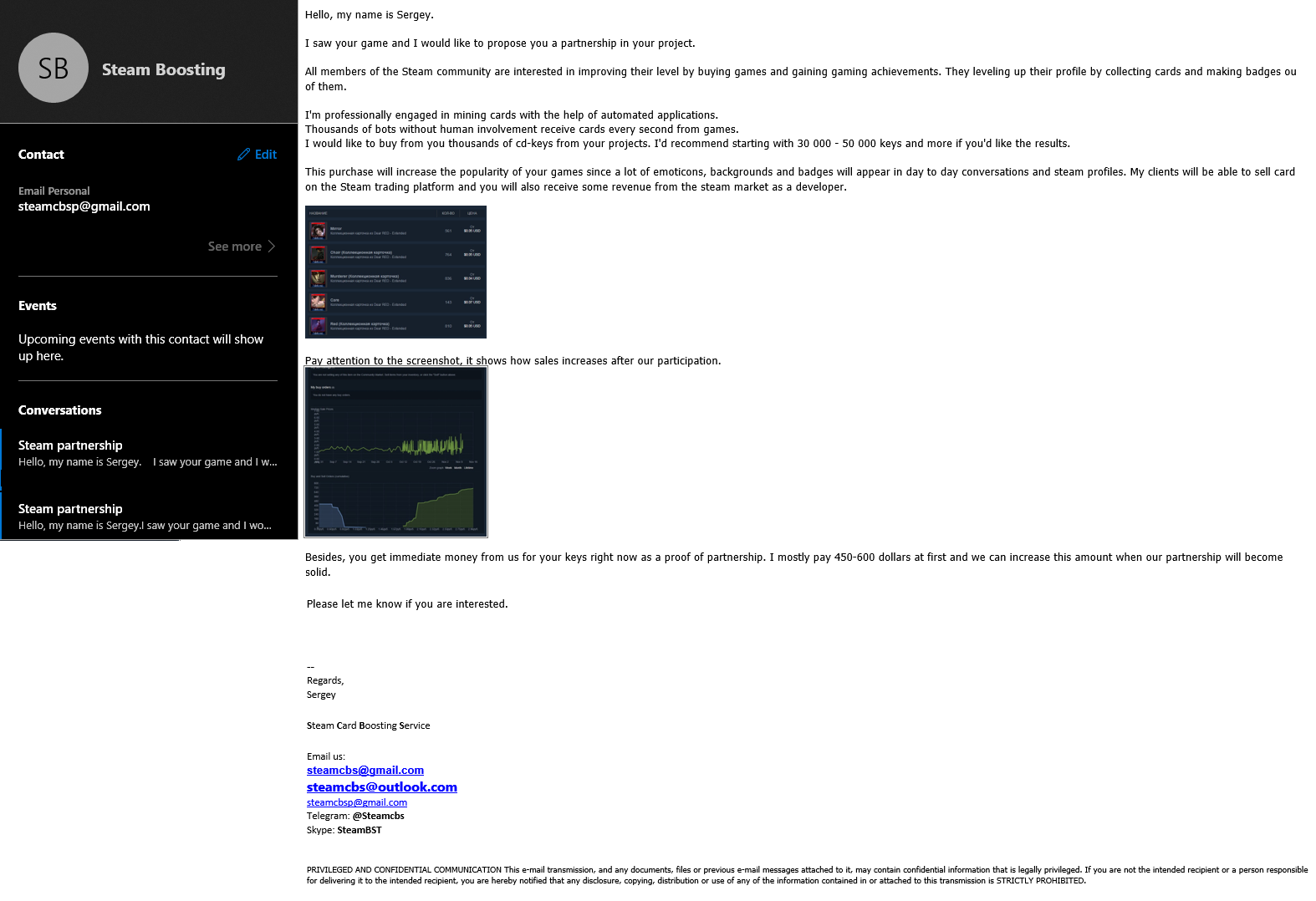
This screenshot was shared by a Steam user Arzola in the “Sentinels of the Store” Steam group, which is a watchdog group that aims to provide transparency to various abuse happening in the Steam ecosystem:
https://steamcommunity.com/groups/Sentinels_of_the_Store/discussions/0/3377008022028633194/
This sales pitch from a bot master about boosting someone’s game rightfully points out the benefit a gamedev studio can get from such a partnership. Note, that this botmaster intends to buy tens of thousands of CD keys for a game that isn’t free to play, just like Killing Floor 2 and unlike most other games with the bot issues, such as Team Fortress 2. I don’t know for sure if TWI ever partnered with the botmasters knowingly, as most of such transactions remain secret, but at the same time I haven’t seen any evidence to the contrary.
I intend this post to hang here for some time before sending emails to the key people who signed the sale documents of TWI to Embracer Group AB and see if they are interested in the amazing finding that the main cash cow game of the company in question is infested with bots. I hope Herr Wingefors will not be disappointed.

In the past, at least during one negative review bombing event, TWI was caught “massaging” its game reviews on Steam, which always seemed suspiciously too positive to me, given how poorly the game is maintained, so it’s not like their reputation was impeccable in this regard.
Regardless of who the bot masters are that manage these bots, TWI has never acknowledged this situation, never commented on it and, to the best of my knowledge, never taken any steps to address it. Moreover, their “community managers” have been deleting not even topics, but mere comments on
Steam Discussions as of recent, that point out that their “in-game” players number is inflated with bots. Which is natural, not much different than the Valve Corporation, the owner of the Steam platform and the developer of Team Fortress 2, never cared about the bots in TF2, until the gamers managed to generate enough negative publicity with their #SaveTF2 campaign by calling Valve out on the bots ruining the gameplay and deceiving the public about the game’s player numbers. In the end, Valve reacted:
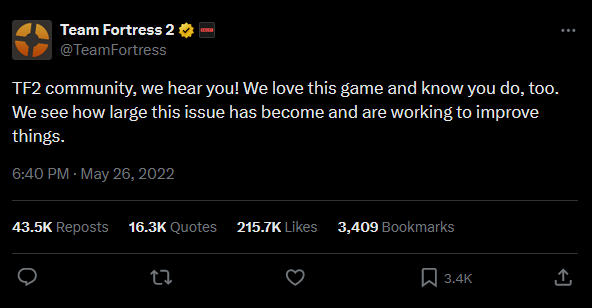
And they did, indeed, improve things. This is one of the reasons why on one of the TF2 related screencaps above you see the amount of total in-game TF2 players being >120K a few years back, but these days it hovers around 70K. One of the ways Valve contributed to resolving this issue is through mass Steam account bans that were suspected in mastering bots in TF2. The point is, they likely wouldn’t have done anything, if not for the negative publicity generated by the gamers #SaveTF2 campaign. Otherwise they are happy with the bots as they contribute to the total platform numbers, not different from how Twitter benefits from having bots, until they get called out on it. For Steam the bots just allow to report to the media that they’ve crossed some next round number which is another reason to show the investors the company’s growing value:
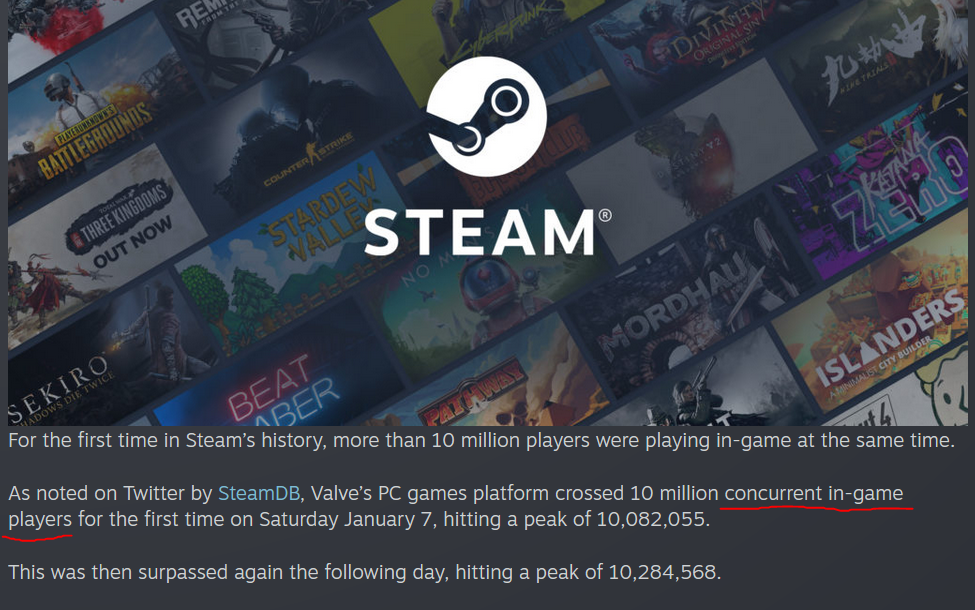
I predict that, because of how easily the in-game players metric can be gamed, Steam will eventually be forced by the public pressure to refine their methodology, maybe similarly to how teamwork.tf web site counts the TF2 concurrent player numbers as opposed to how Steam counts them. One of the major reasons the gamers pay attention to this number is they are trying to assess if the game is dead or alive and if they can find the lobbies easily. Obviously, the current Steam methodology to collect and report these numbers deceives such gamers in the case of KF2.
Conclusion
Main take away points:
* Killing Floor 2, the main cash cow game of Tripwire Interactive LLC game studio, is infested with bots, which constitute from 60 to 90% of the total in-game player numbers, depending on a season and bot masters activity;
* The bot situation is proven using two independent methods, through pattern analysis and direct online player counting;
* Currently and across the last year, the real number of online players worldwide was hovering around 1K, from 670 to 1,295 with seasonal spikes due to updates or free 2 play weekends up to 2,107 or 5,435, which, however, never last for long and get back to the hovering around 1K in 1-2 months;
* The most likely explanation is these are trading card and in-game item drop farming bots, but I can’t rule out that TWI themselves might be inflating the numbers for the purpose of getting some leverage when selling the company;
* Public and media (example from “Gamerant“) are largely being misinformed about the player numbers;
* TWI never acknowledged or addressed this situation. Instead, they choose to delete the comments pointing out that their “in-game” players number is fake.
More TWI related spicy content is coming, make sure you bookmark this web site and join our Steam group, where all these scoops get posted initially.

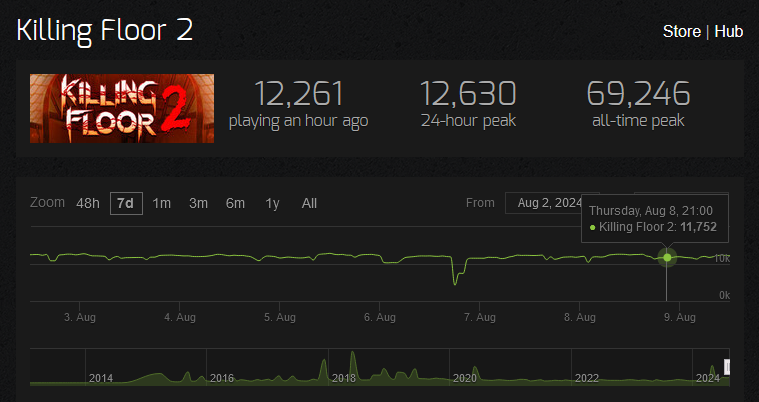
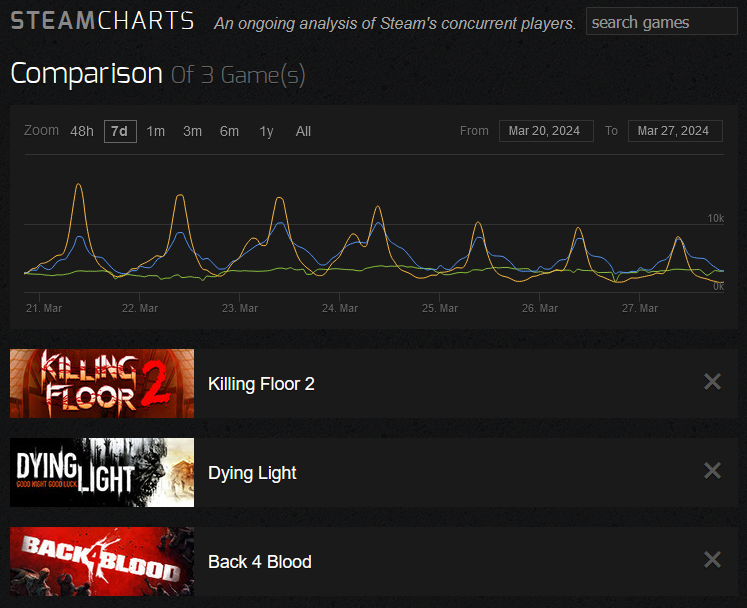
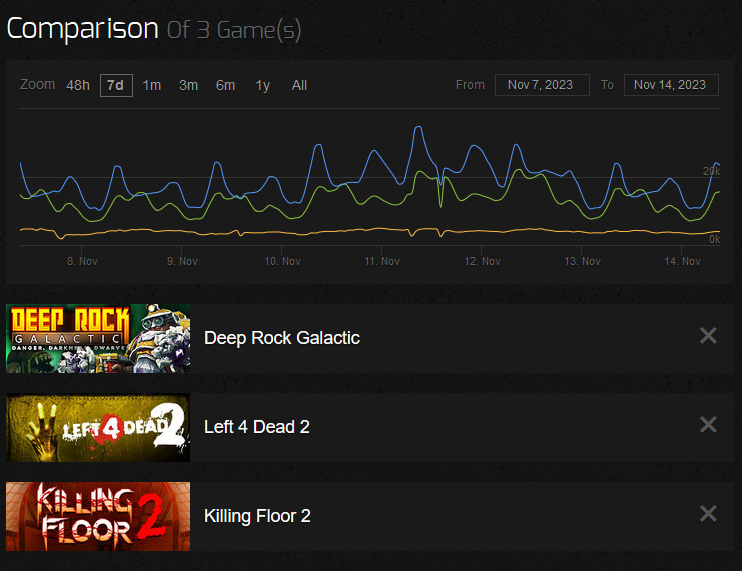
What the fuck this goyim knows that we are trying to look more profitable to our big Jew investors. SHUT IT DOWN!!!